Physical Address
304 North Cardinal St.
Dorchester Center, MA 02124
More than in any other organ system, the normal imaging appearance of the skeletal system is strikingly different in children as compared to adults ( Fig. 7-1 ). This is related to the changing appearance of growing and maturing bone. The most striking changes occur near the physes and apophyses. Many of the more common mistakes made in pediatric skeletal radiology are related to the misinterpretation of normal structures as being abnormal. Textbooks such as Keats's Atlas of Normal Roentgen Variants That May Simulate Disease are dedicated to the normal radiographic appearances and variations of bones in children. The details of all the normal changes of the maturing skeleton cannot be covered here. The following section describes several commonly misinterpreted normal variants and benign entities.
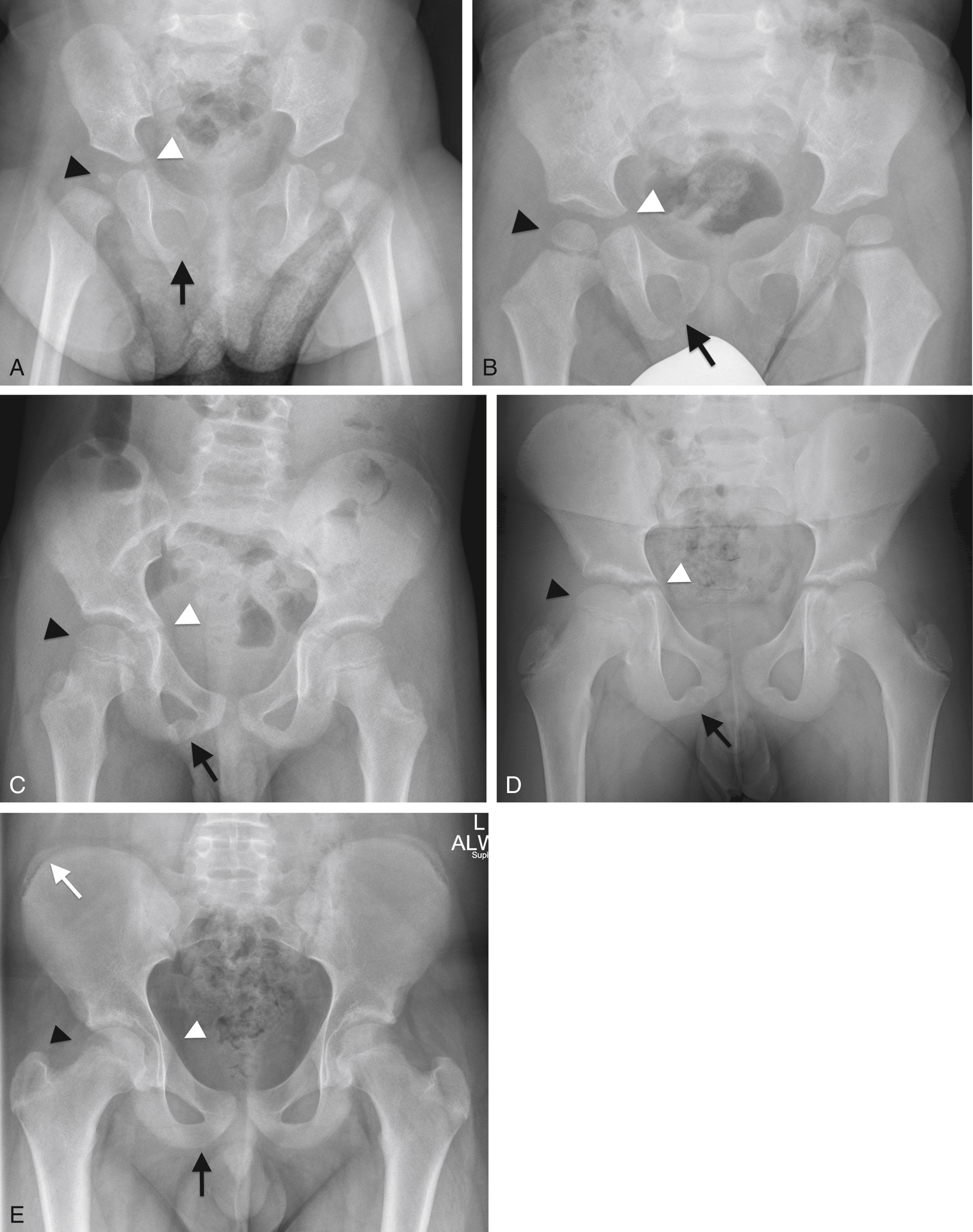
The terms apophysis and epiphysis sound similar and have similar meanings. Their differences can be confusing. The term epiphysis refers to the part of bone that articulates with the adjacent bone. An a pophysis does not have an articular surface. Instead, it is a site of tendinous attachment. The growth plate, or physis, has a different appearance when associated with an epiphysis or apophysis. Epiphyseal growth plates are the primary growth centers of long bones. The physis associated with an epiphysis is oriented perpendicular to the longitudinal axis of the bone. This differs from the physis of an apophysis which is parallel to the long axis of the bone.
In the growing child, apophyses and epiphyses in various parts of the body can have variable and often somewhat irregular appearances. Separate ossicles of an apophysis can mimic fragments, irregularity can mimic periosteal reaction, and mixed sclerosis and lucency can be confused with findings of an inflammatory or neoplastic process. Common apophyses that may have this appearance include tibial tuberosity, ischial tuberosity, ischial pubic synchondrosis, posterior calcaneal apophysis ( Fig. 7-2 ), and medial malleolus of the ankle ( Fig. 7-3 ). Irregularity and fragmentation are commonly seen in the normal tibial tuberosity. The calcaneal apophysis can often demonstrate a strikingly sclerotic appearance (see Fig. 7-2 , C ). The ischial pubic synchondrosis can appear very prominent (see Fig. 7-1 , D ) and asymmetric.

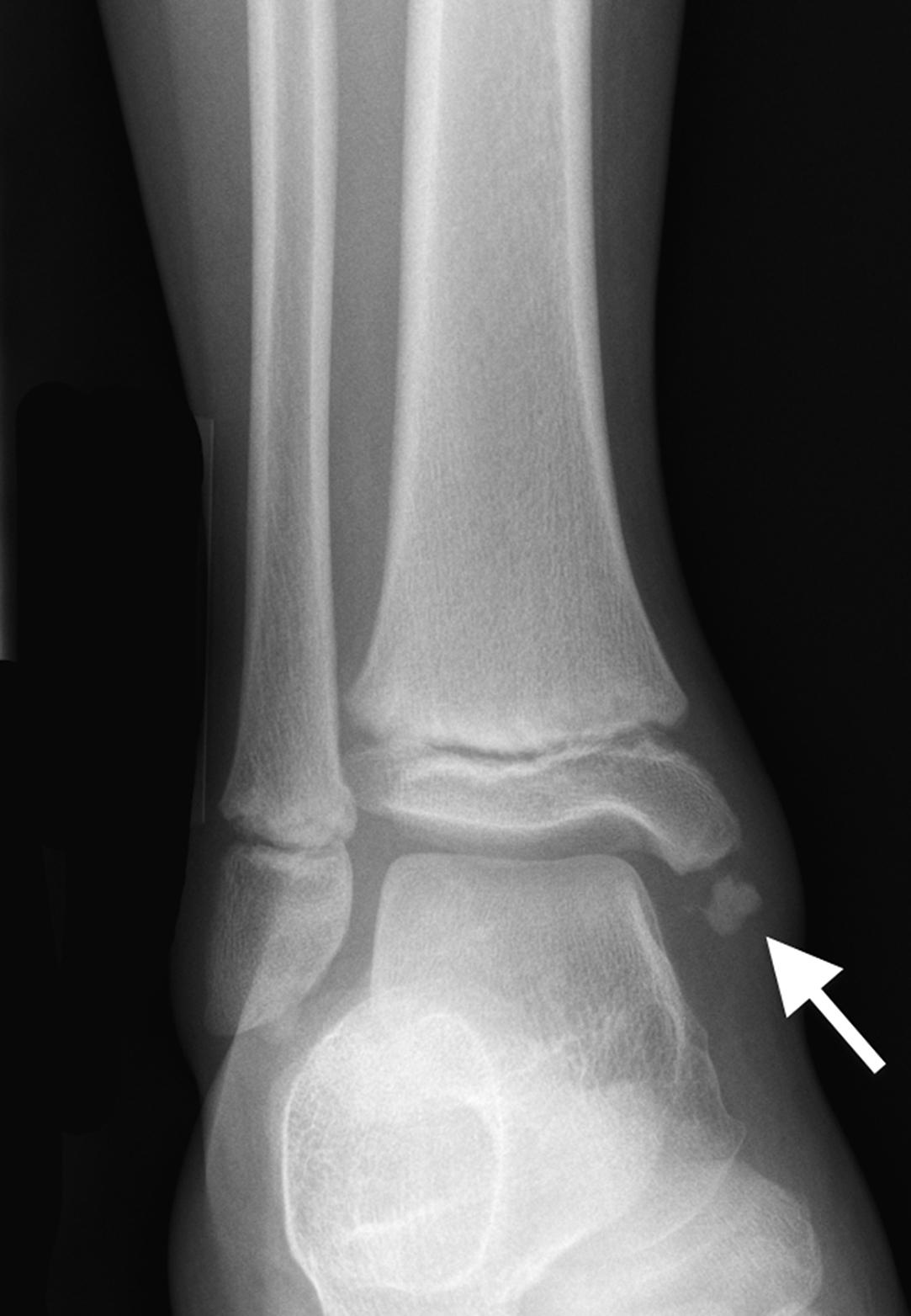
Epiphyses can also appear irregular and even fragmented. The most common epiphyses with this irregular appearance are the distal femoral epiphysis ( Fig. 7-4 ) and the capitellum ( Fig. 7-5 ). It is important to recognize these irregularities as a normal stage of development and not confuse them with osteochondral lesions (in the distal femoral epiphysis or the capitellum) or with fracture (medial malleolus).


Distal femoral metaphyseal irregularity, also referred to as cortical desmoid or cortical irregularity syndrome, refers to the presence of irregular cortical margination and associated lucency involving the posteromedial aspect of the distal femoral metaphysis. It occurs in approximately 10% of boys 10–15 years of age. Although debated, its presence is thought to be related to chronic strain at the insertion of the adductor magnus muscle. While this lesion can be associated with pain, it is often discovered incidentally, and its significance lies in its striking radiographic appearance. On radiography, there is cortical irregularity along the posteromedial cortex of the distal femoral metaphysis, best seen on the lateral view ( Fig. 7-6 ). On frontal radiographs, there may be an associated lucency (see Fig. 7-6, B ). Familiarity with the typical location, appearance, and patient age is important so that these lesions are not confused with aggressive malignancies. Because the lesions are often bilateral, confirmation of their benign nature can be made by demonstrating a similar lesion on radiographs of the opposite knee. In problematic cases, computed tomography (CT) or magnetic resonance imaging (MRI) can be used to demonstrate the characteristic findings: a characteristic scoop-like defect with an irregular but intact cortex; no associated soft tissue mass; and a subtle contralateral lesion.
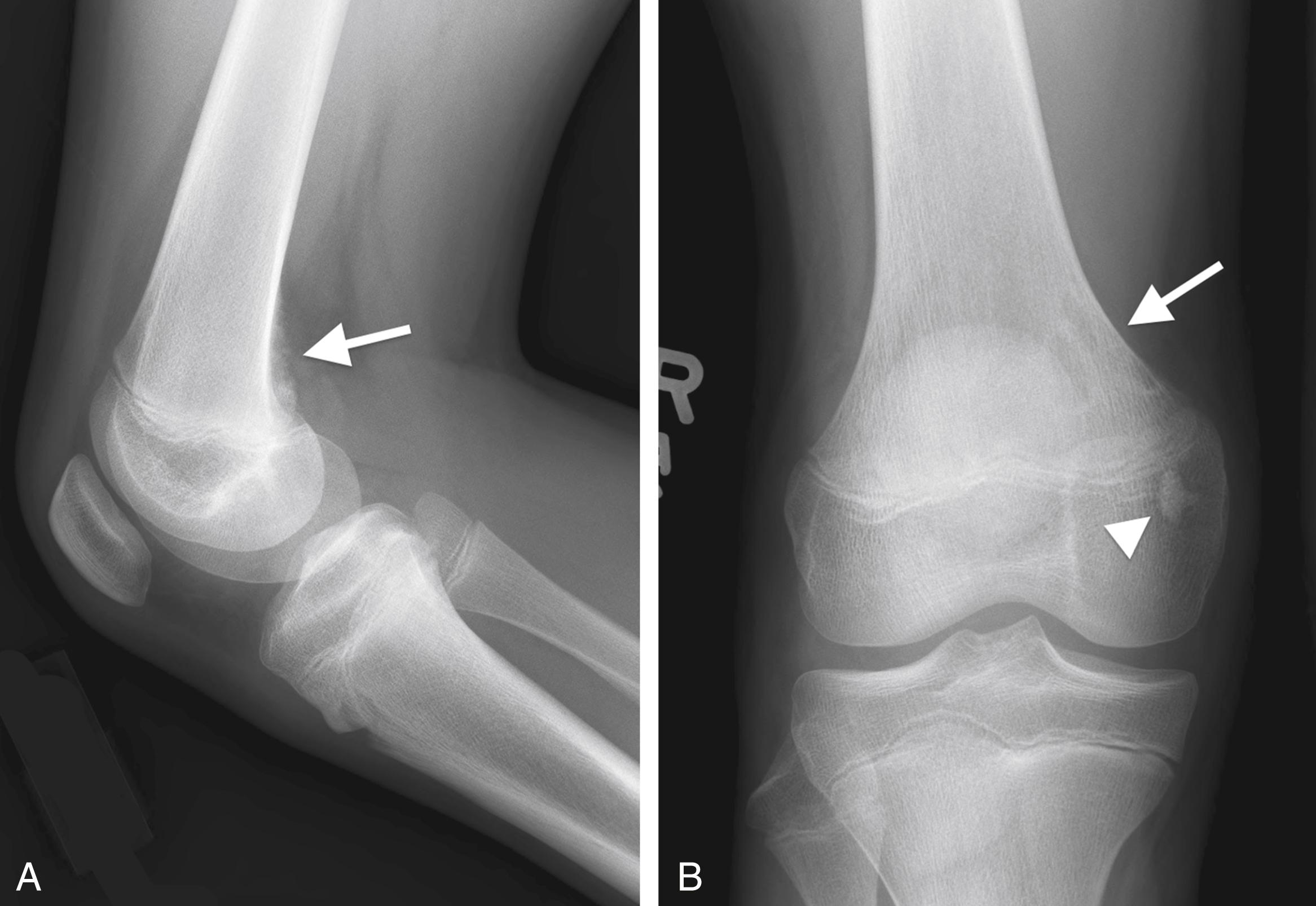
Benign fibrous cortical defects, or nonossifying fibromas, are commonly encountered lesions of no clinical significance. They are seen in up to 40% of children at some time during development and most commonly occur between five and six years of age. The term nonossifying fibroma is reserved for lesions larger than 3 cm in diameter. They occur most commonly within the bones around the knee and in the distal tibia. They appear as eccentrically based, well-defined, bubbly, lucent lesions. These benign tumors have a narrow zone of transition with thin cortical rims ( Figs. 7-7 through 7-9 ) and are typically round or oval. When the characteristic pattern is identified, no further imaging or follow-up is necessary. Occasionally a pathologic fracture can occur through the lesion (see Fig. 7-9 ). Over time, benign fibrous cortical defects become more sclerotic and eventually resolve (see Figs. 7-8 ). When imaged during this healing process, they are sometimes referred to as ossifying nonossifying fibromas.
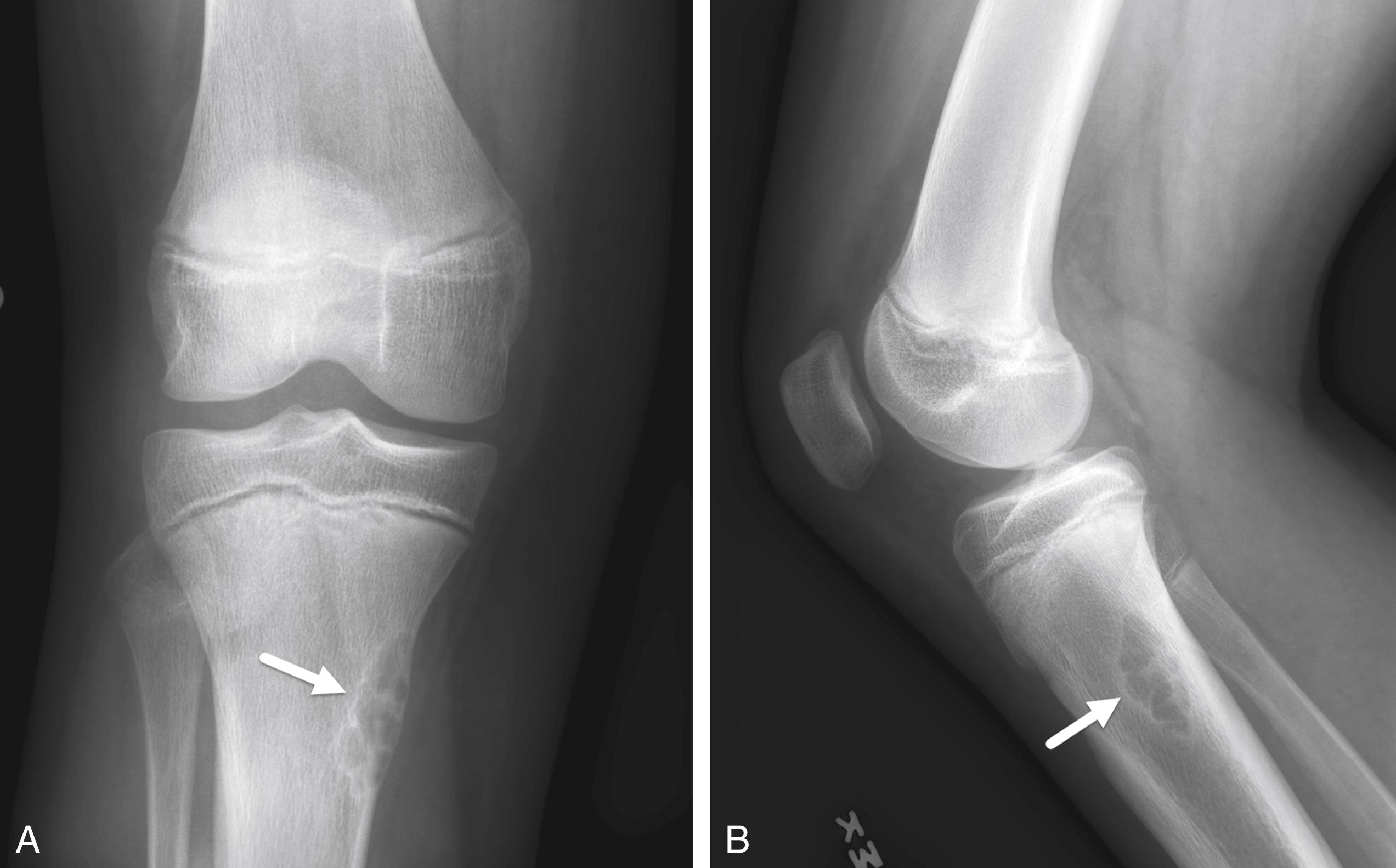
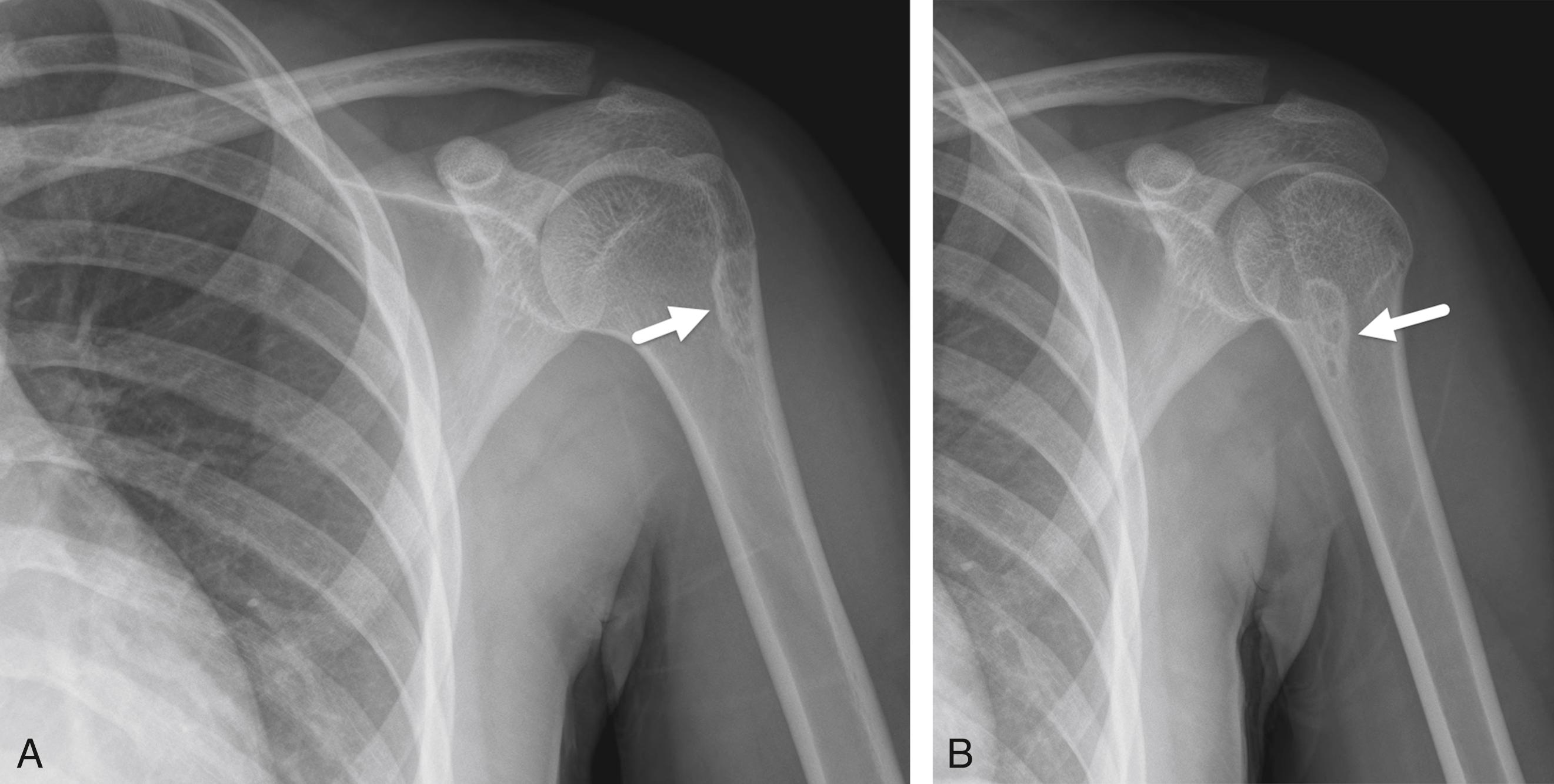
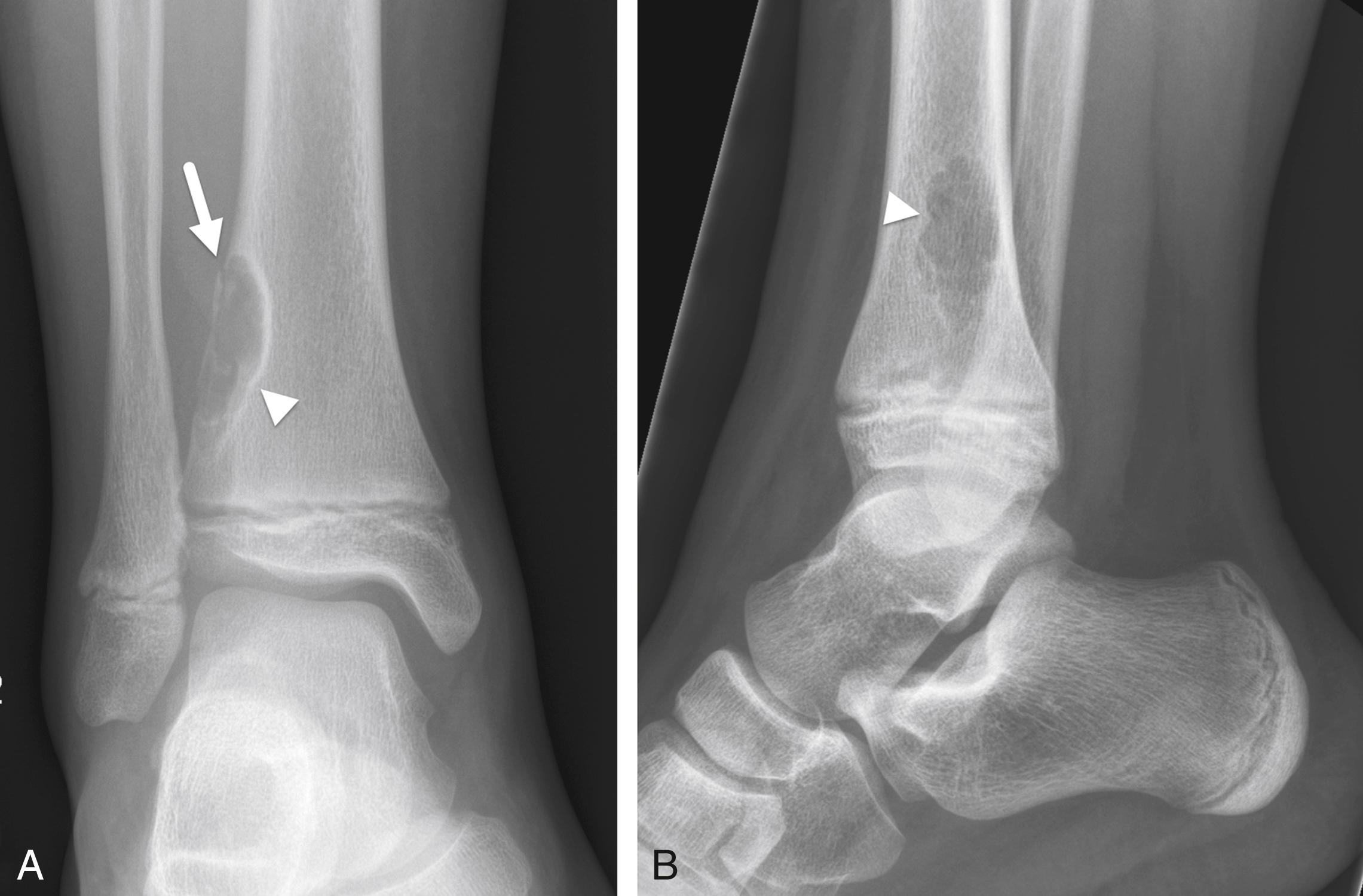
Fractures in children differ from those in adults for multiple reasons. Children's bones have higher water content and are thus more pliable with a greater propensity to deform before breaking. This is akin to a new branch, or green stick, on a tree. Green sticks, with their higher water content, bend and deform before breaking.
The term incomplete fracture ( Fig. 7-10 ) refers to a fracture that does not extend through the entire diameter of the cortex. Because children's bones are more elastic, incomplete fractures occur more commonly in children than adults. There are several types of incomplete fractures. Plastic bowing deformity ( Fig. 7-11 ) is diagnosed when there is a greater than expected curvature of the bone after trauma without a discrete fracture line. This type of fracture occurs almost exclusively in the radius, ulna, or fibula. At times, a plastic bowing injury can be difficult to diagnose, and it is not until the follow-up image, when periosteal new bone is present, that the fracture can confidently be diagnosed. A buckle fracture is an incomplete fracture at the junction of the metaphysis and diaphysis along the compressive side of bone. It results in a bulge of one cortical surface. Importantly, there is no cortical disruption. Buckle fractures may be subtle and may appear only as an increase in angulation of a normally gentler curve ( Fig. 7-12 ). Buckle fractures are most common in the distal radius and ulna, the metacarpals and metatarsals, the phalanges, and the tibia ( Fig. 7-13 ). Finally, a greenstick fracture is an incomplete fracture along the tension side of a bowing bone ( Fig. 7-14 ). Greenstick fractures are most common in the forearm.

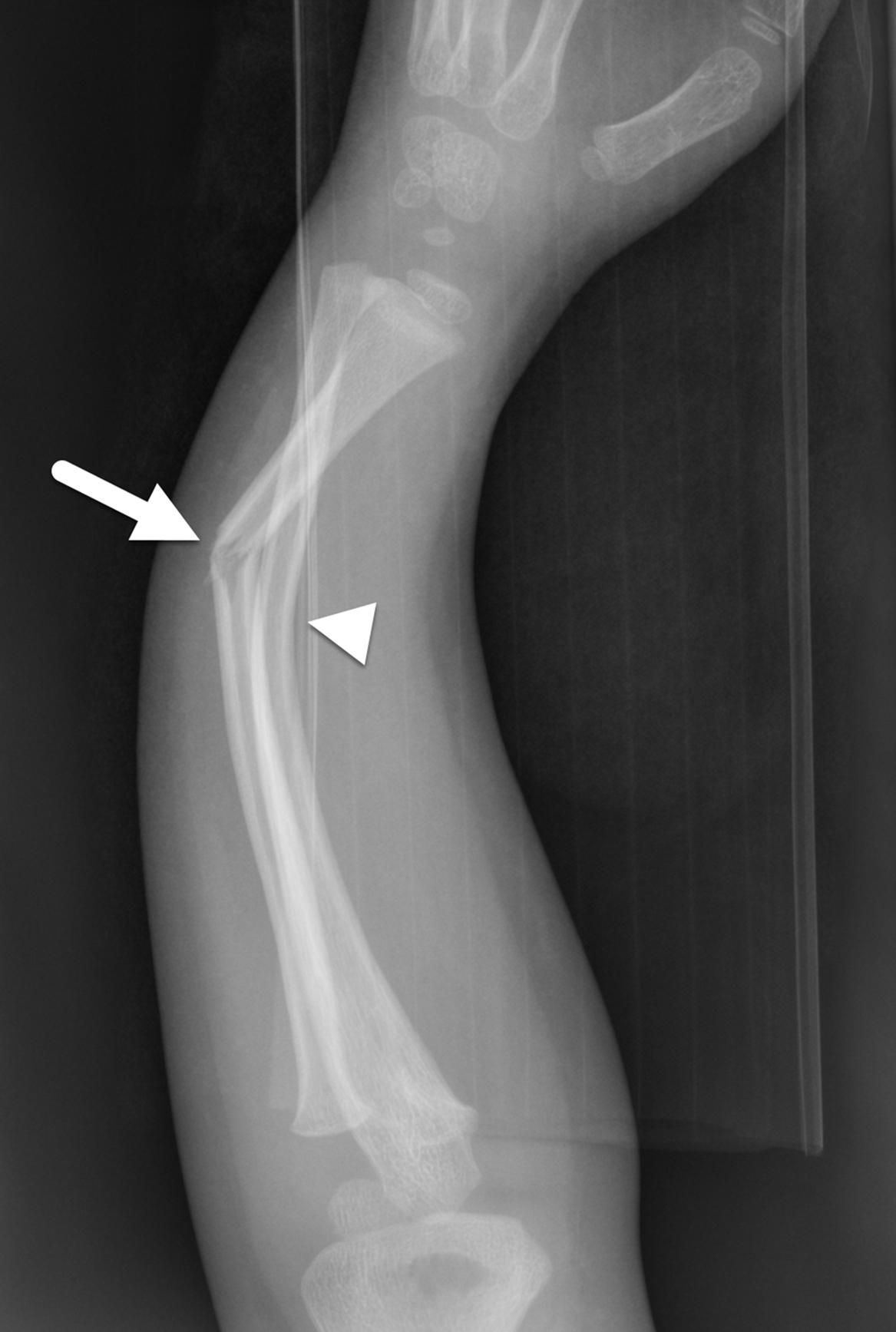
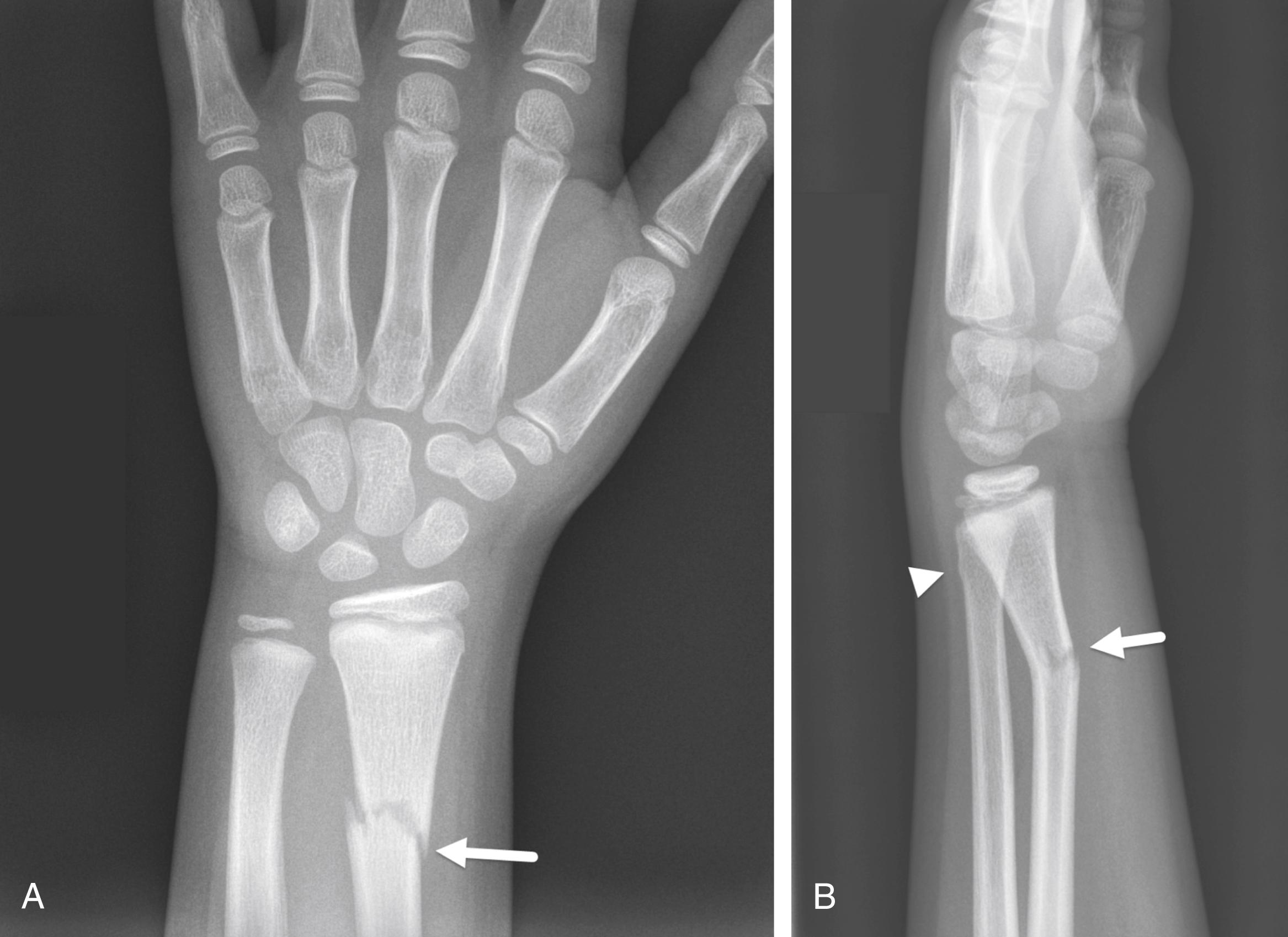

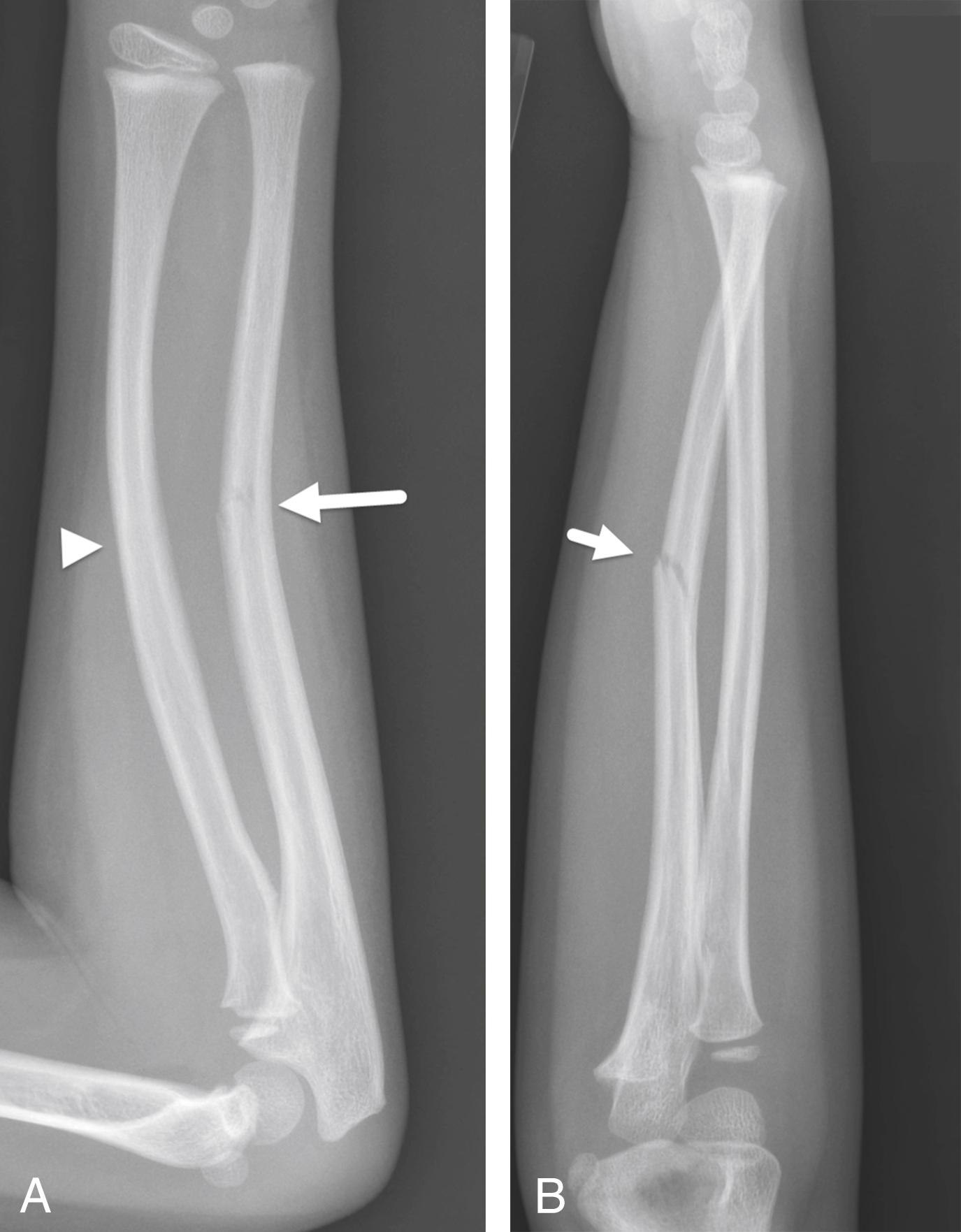
The potential for healing and the healing rate of fractures also differ in children and adults. Younger children heal very quickly. Periosteal reaction can be expected to be radiographically present 10–14 days after injuries in children. Children also tend to heal completely. Nonunited fractures are very uncommon in children.
When describing fractures in children, the degree of displacement can help to guide the type of therapy and the need for orthopedic referral. Displacement can be described in terms of its type, direction, and magnitude. There are five main types of displacement: translation, angulation, shortening, distraction, and rotation. The term translation refers to the lateral motion of the fracture fragment. Angulation is measured and described in relation to the apex of the curve. Shortening and distraction refer to motion along the longitudinal axis of the bone. Finally, rotation is a more complex type of angulation where the motion of the fracture fragment occurs in relation to a fixed point.
Fractures in children may involve of the physis in up to 18% of pediatric long bone fractures. Physeal involvement requires internal fixation at a higher rate and may result in growth arrest of the affected limb. The Salter–Harris classification system is used to describe fractures that involve the physis. It divides fractures into five types according to whether there is involvement of the physis, epiphysis, or metaphysis, as determined by radiography ( Fig. 7-15 ). Fractures classified with a greater Salter–Harris type are more likely to result in growth arrest. Type I fractures involve only the physis ( Fig. 7-16 ). They tend to occur in children younger than five years of age. On radiography, the epiphysis may appear to be displaced in comparison with the metaphysis. However, type I fractures often reduce before the radiographs being obtained, making diagnosis extremely difficult. The potential findings of a type I fracture include soft tissue swelling adjacent to the physis, asymmetric widening of the physis, and/or displacement of the epiphysis. Salter–Harris type I injuries are uncommon and may only occur at the distal fibula and the proximal femur (as in a slipped capital femoral epiphysis [SCFE]). Type II fractures involve the metaphysis and physis but do not involve the epiphysis ( Figs. 7-17 and 7-18 ). They are the most common type of physeal injury, accounting for up to 75% of Salter–Harris fractures. On radiography, there is typically a triangular fragment of the metaphysis attached to the physis and epiphysis. Type III fractures involve the physis and epiphysis but not the metaphysis ( Figs. 7-19 and 7-20 ). Type III injuries have a greater predisposition for growth arrest. Type IV injuries involve the epiphysis, physis, and metaphysis and, like type III injuries, are associated with a high rate of growth arrest ( Fig. 7-21 ). Type V fractures consist of a crush injury to a part of or all of the physis. Like type I injuries, type V injuries are extremely difficult to diagnose. Often a diagnosis can be made only with a suspicious clinical history and comparison to the contralateral physis. With all Salter–Harris type fractures, it is important to assess the physis on follow-up images. Posttraumatic growth arrest is detected radiographically by demonstration of a bony bridge across the physis ( Fig. 7-22 ).


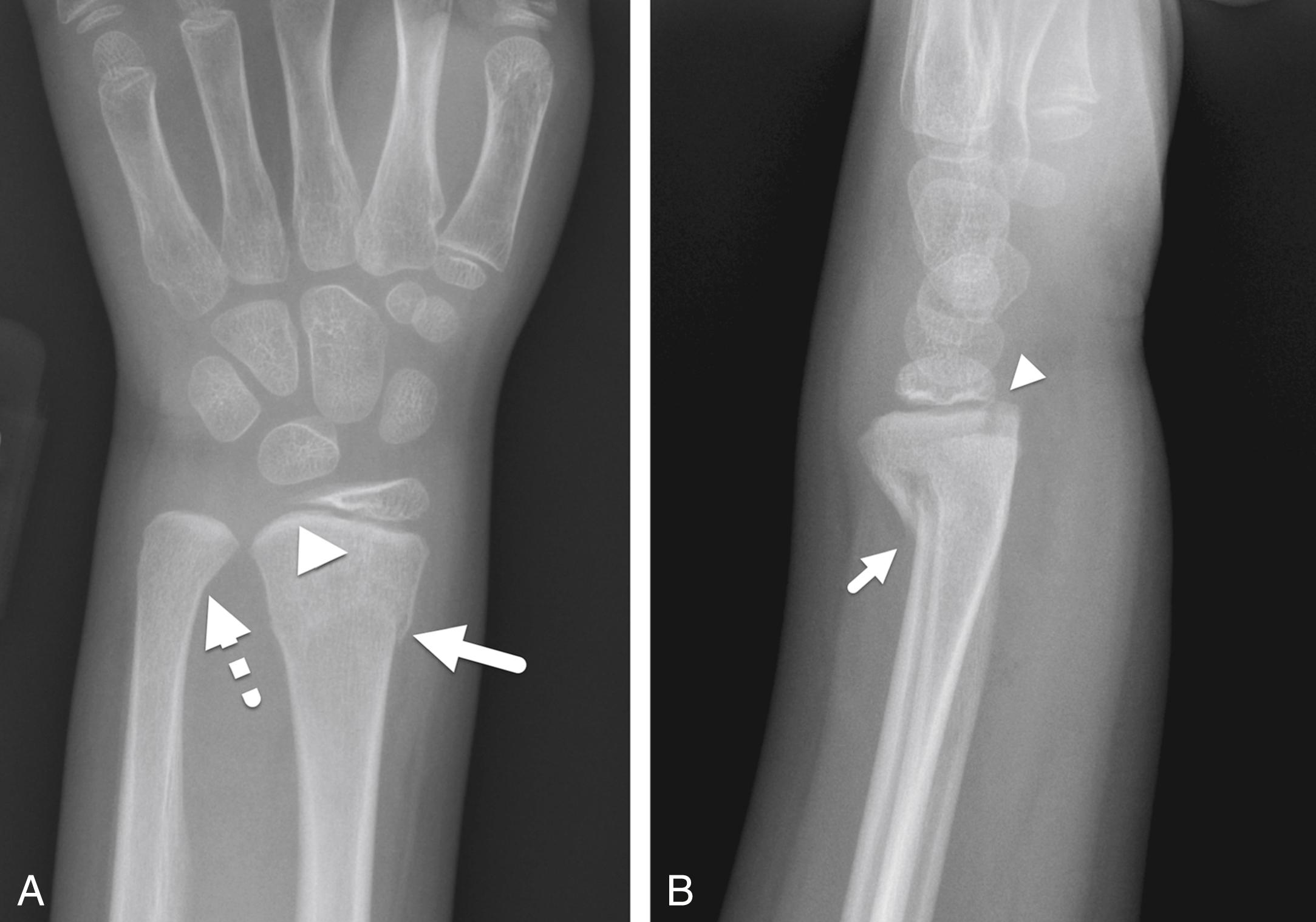
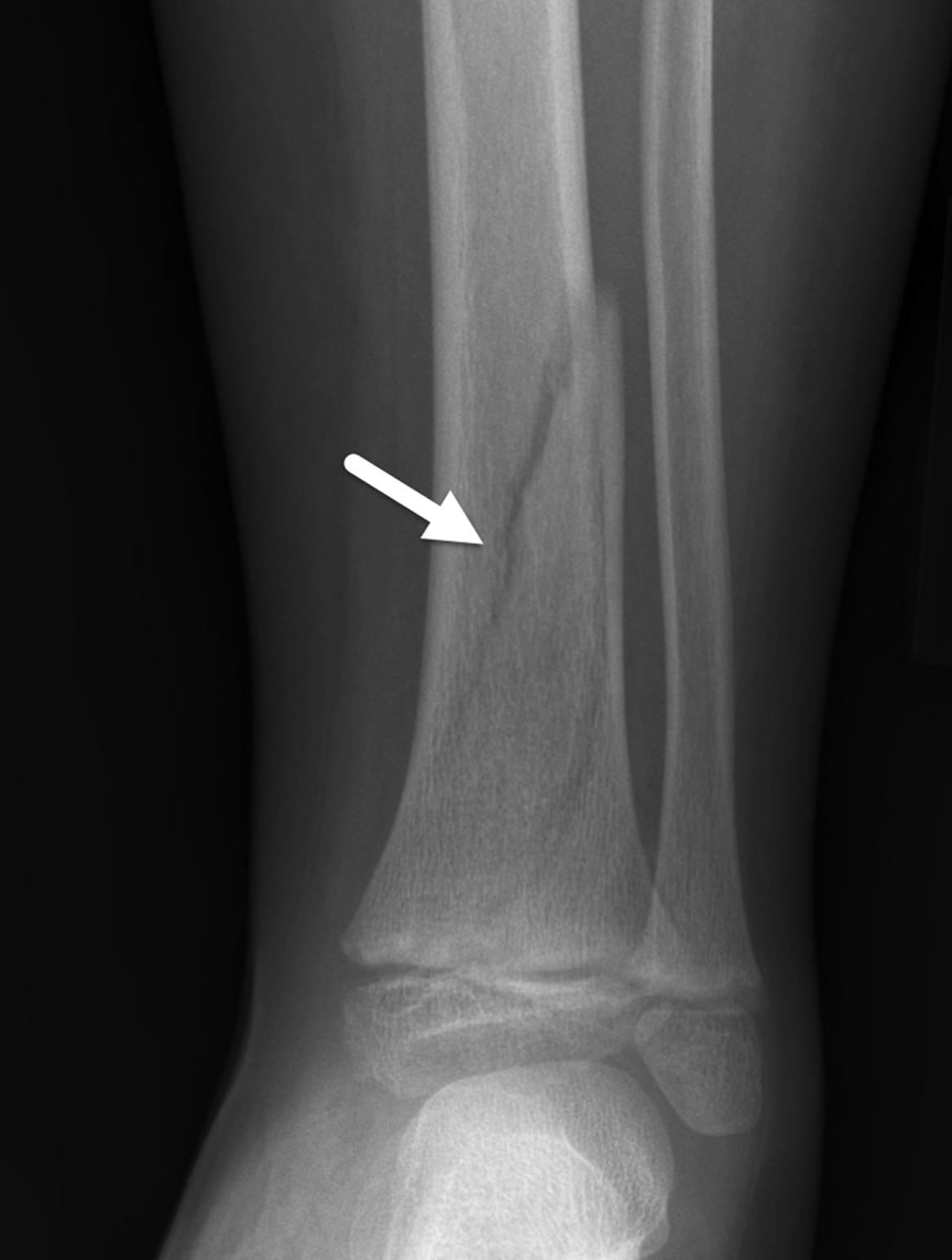
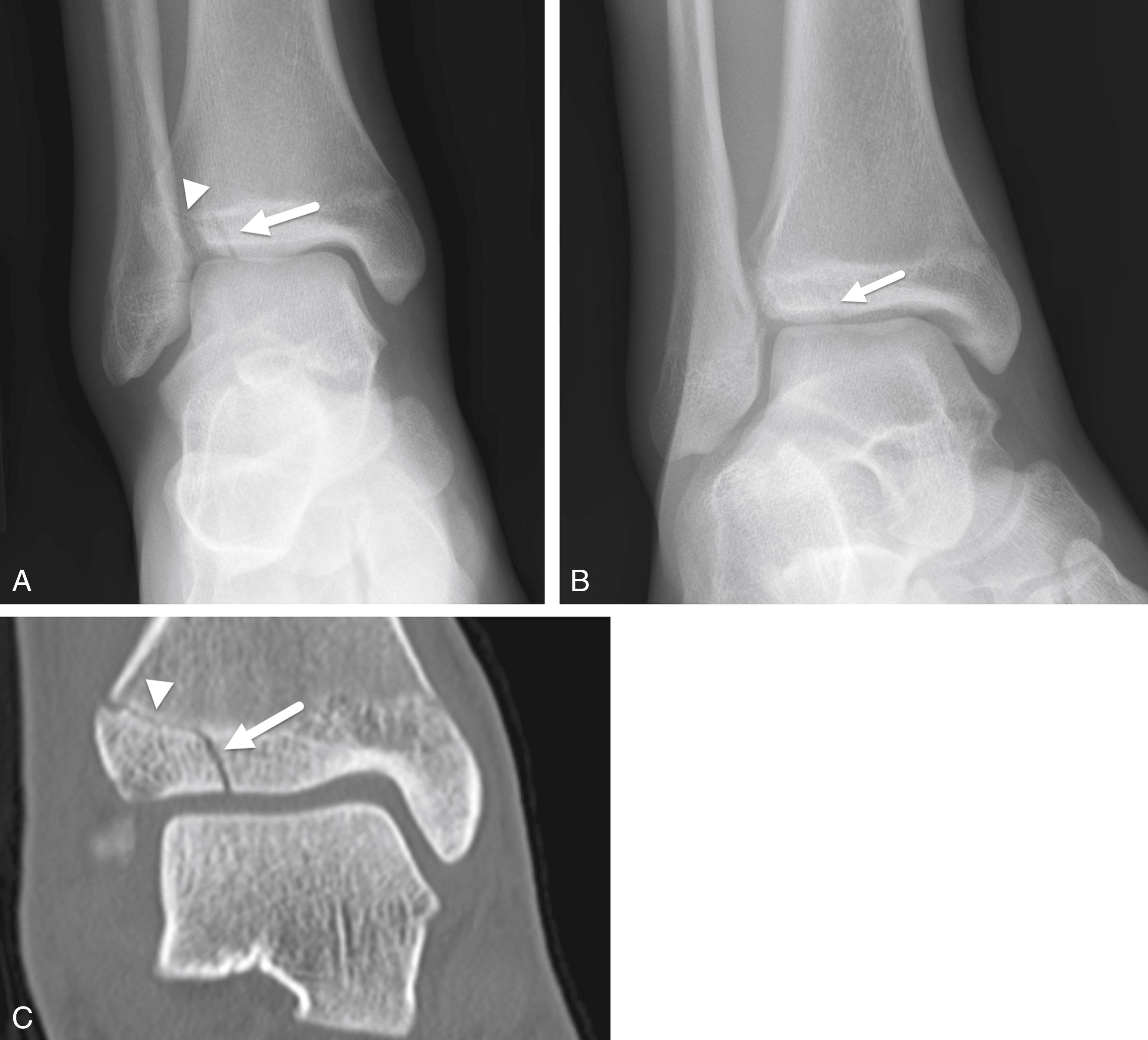
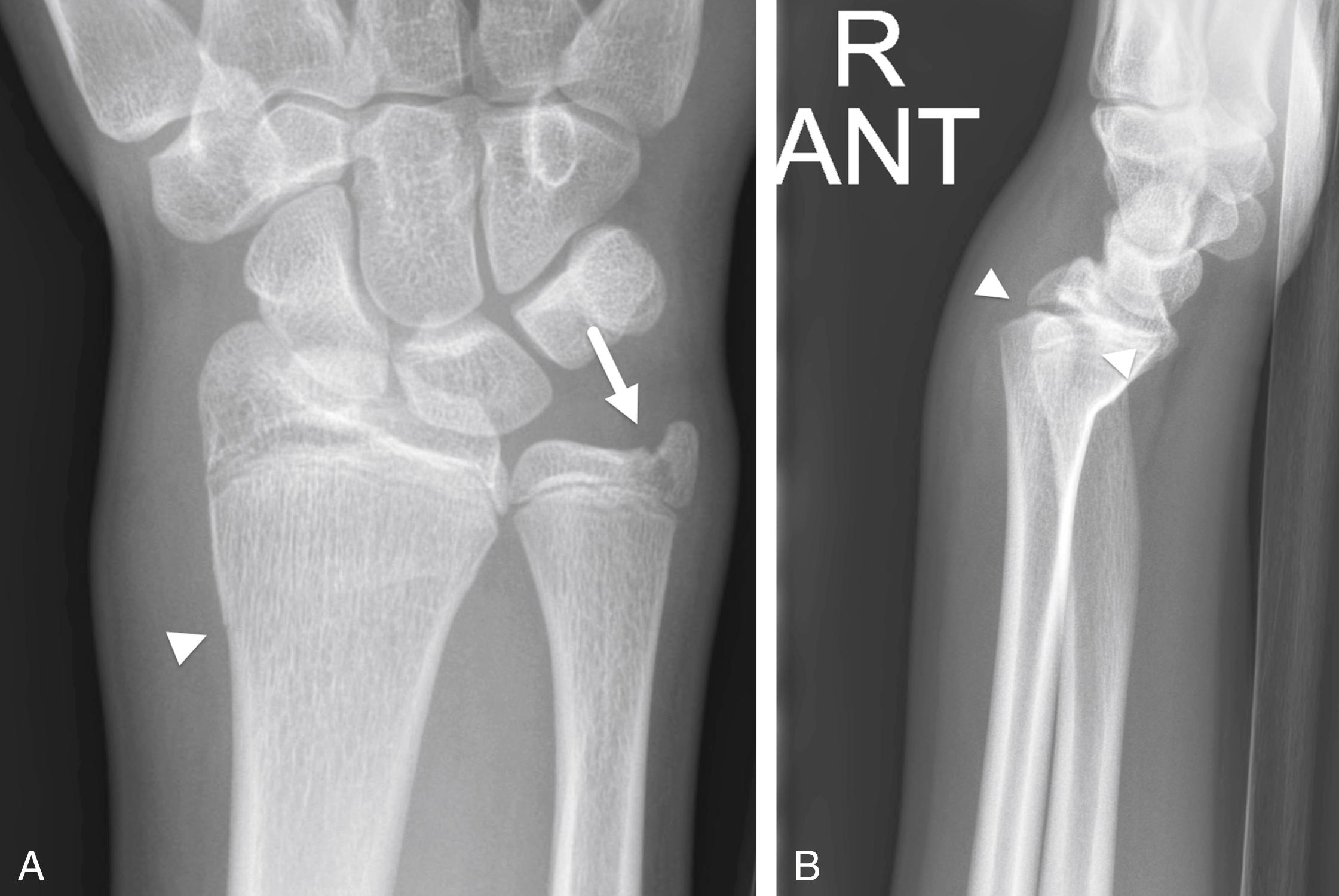
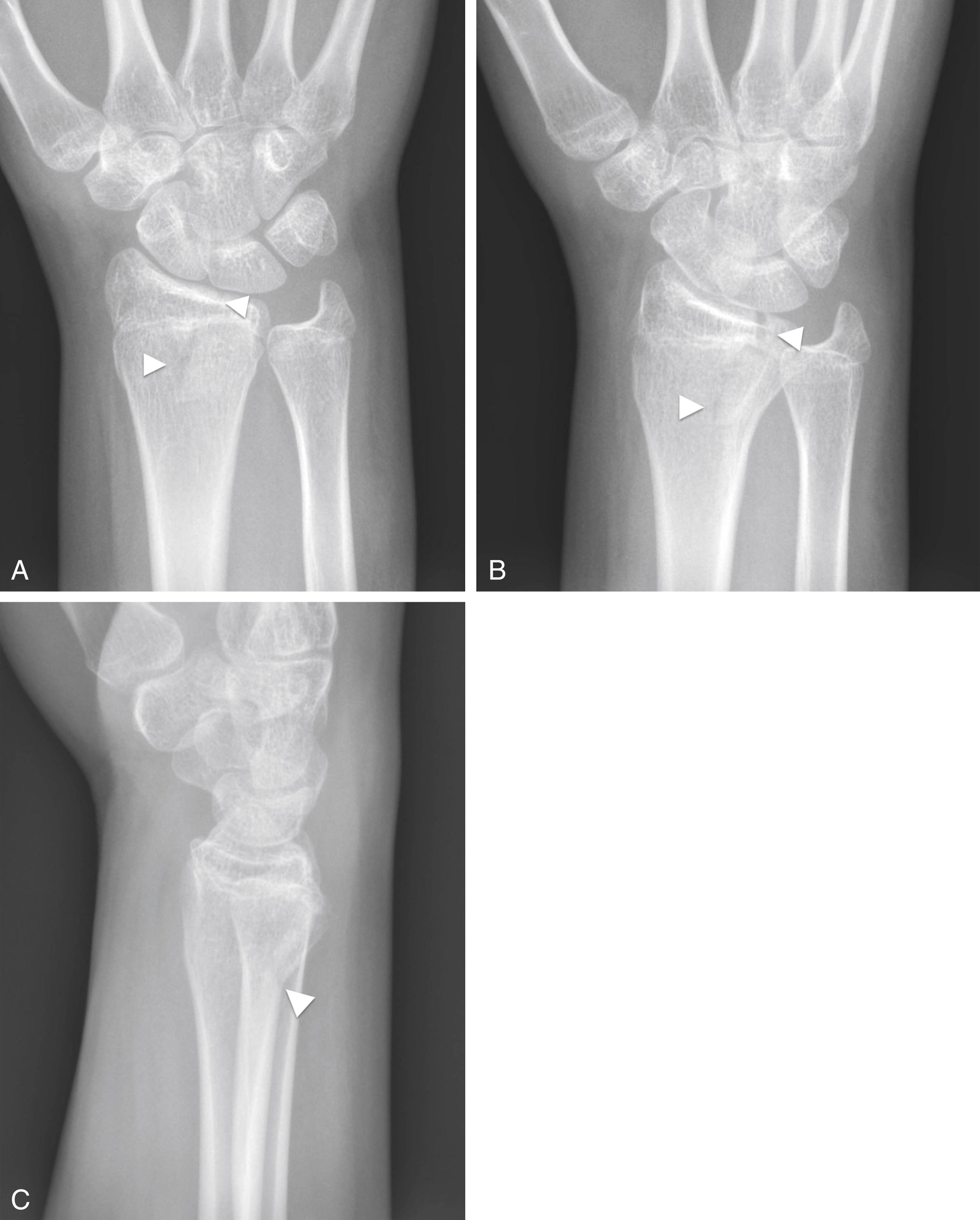
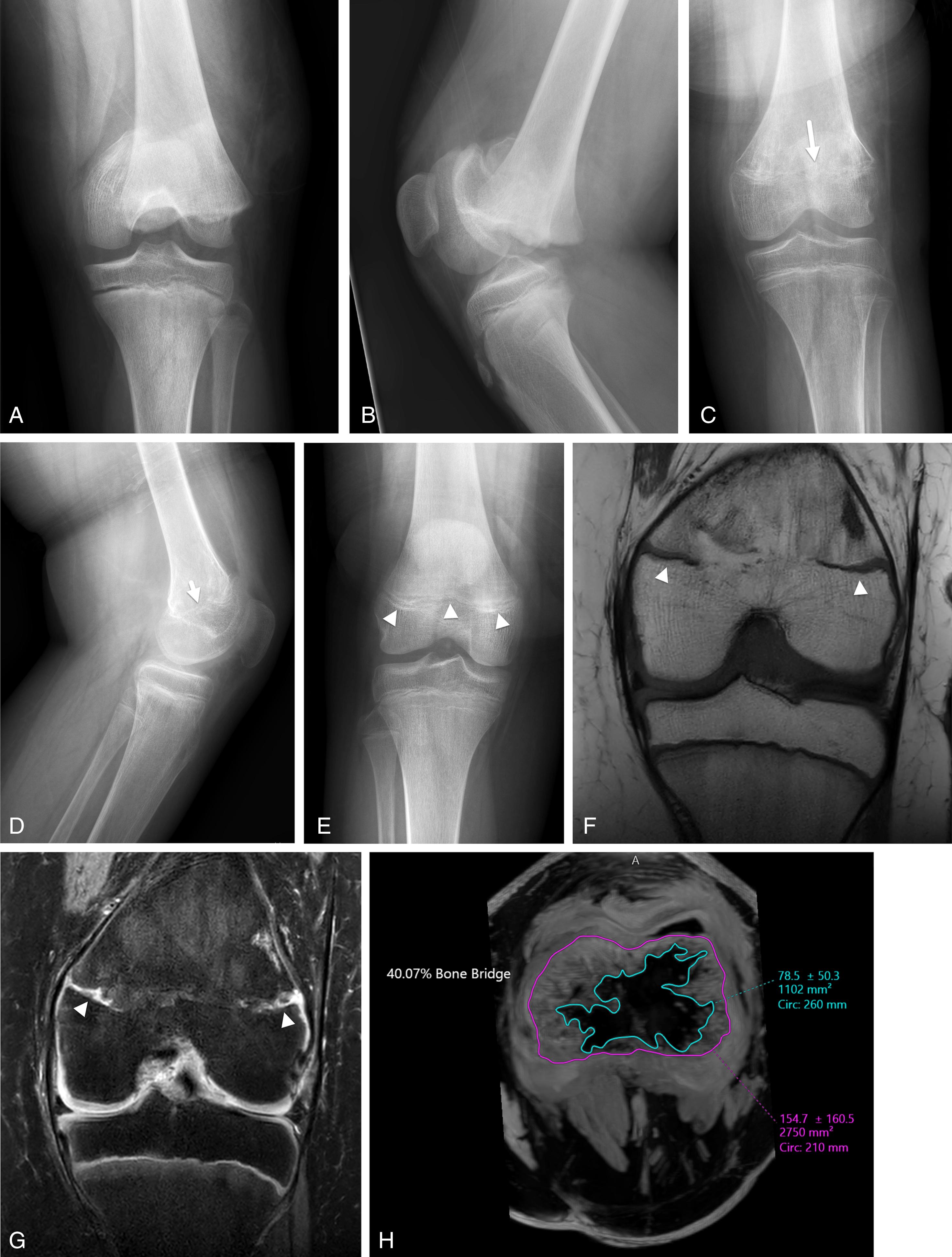
Pediatric fractures have unique features in almost all locations. The following material reviews several of the more commonly encountered areas.
The wrist is the most common site of fracture in children. Most fractures of the distal forearm are incomplete or transverse fractures of the distal metaphysis of the radius, with or without fracture of the distal ulnar metaphysis or styloid ( Figs. 7-17, 7-20, 7-21, and 7-23 ). It is important to assess all fractures of the distal radius for extension of the fracture line to the physis because the distal radius is also the most common area of physeal fracture (28% of physeal injuries occur in the distal radius). Vertical extension of a distal radius fracture to the physis is often subtle. However, this type of physeal extension is important for the pediatric radiologist to identify and describe as it can necessitate orthopedic referral.
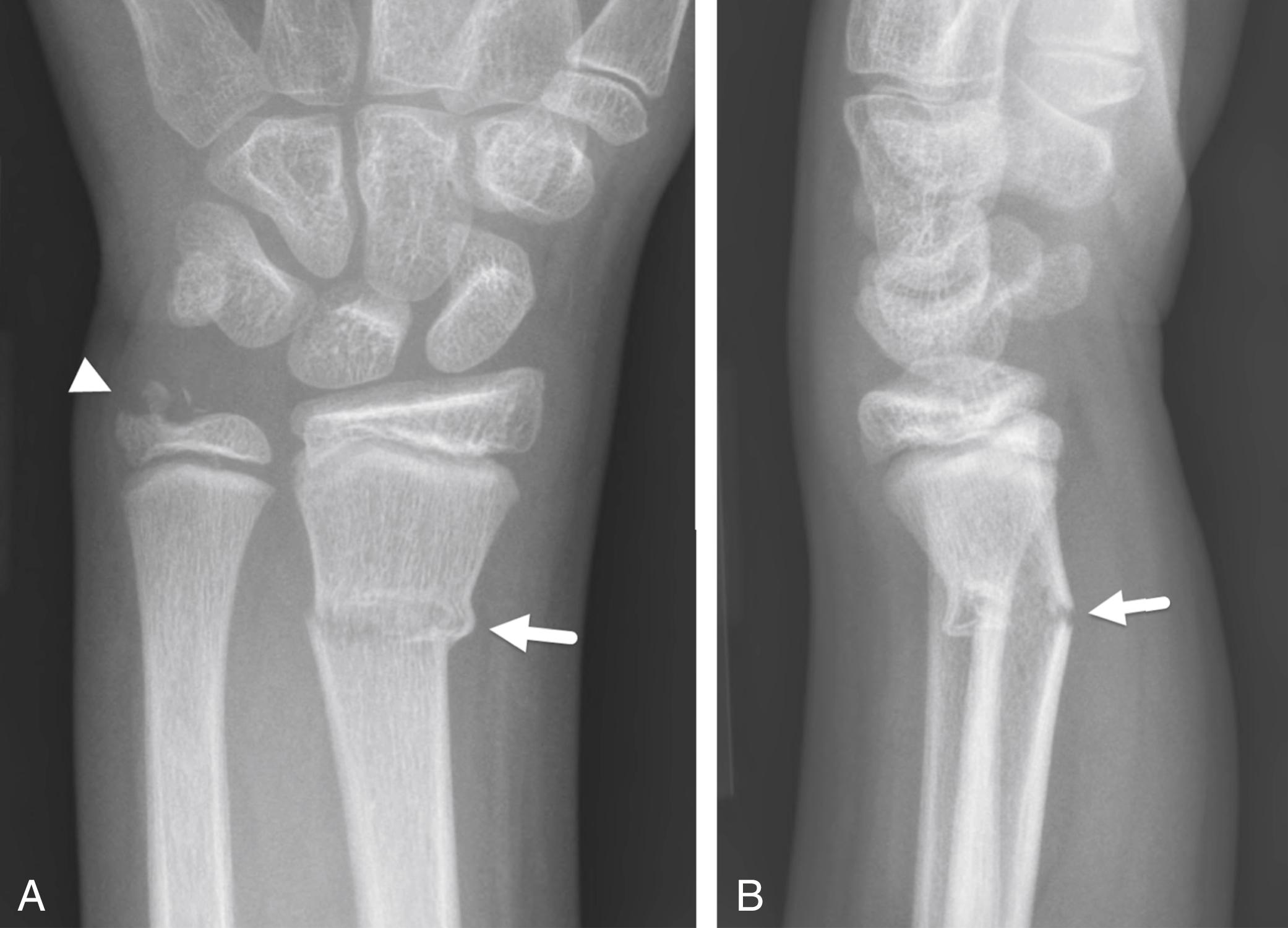
Displacement or obliteration of the pronator fat pad indicates a fracture or deep soft tissue injury. The normal pronator fat pad is visualized on a lateral view of the forearm as a thin line of fat with a mildly convex border. In most distal forearm fractures, the convexity of the pronator fat pad is increased or the fat pad becomes obliterated by soft tissue attenuation.
There are several unusual features that make elbow injuries in children different from those in adults. In contrast to adults, in whom fracture of the radial head is the most common injury, children most commonly experience supracondylar fractures ( Figs. 7-24 and 7-25 ). They occur secondary to hyperextension that occurs when falling on an outstretched arm. As many as 25% of such fractures are incomplete and may be subtle on radiography. On radiographs, there can be posterior displacement of the distal fragment such that a line drawn down the anterior cortex of the humerus (anterior humeral line) no longer bisects the middle third of the capitellum. The fracture line is usually best seen through the anterior cortex of the distal humerus on the lateral view. A joint effusion is typically evident. Elbow effusions are identified when there is displacement of the posterior fat pad, resulting in its visualization on a lateral view ( Figs. 7-24 through 7-26 ). Normally the posterior fat pad rests within the olecranon fossa and is not visible on a true lateral view of the elbow. However, when an effusion is present, the posterior fat pad is elevated by the joint fluid. The anterior fat pad, which is normally visible, may become prominent and have an apex anterior convexity.
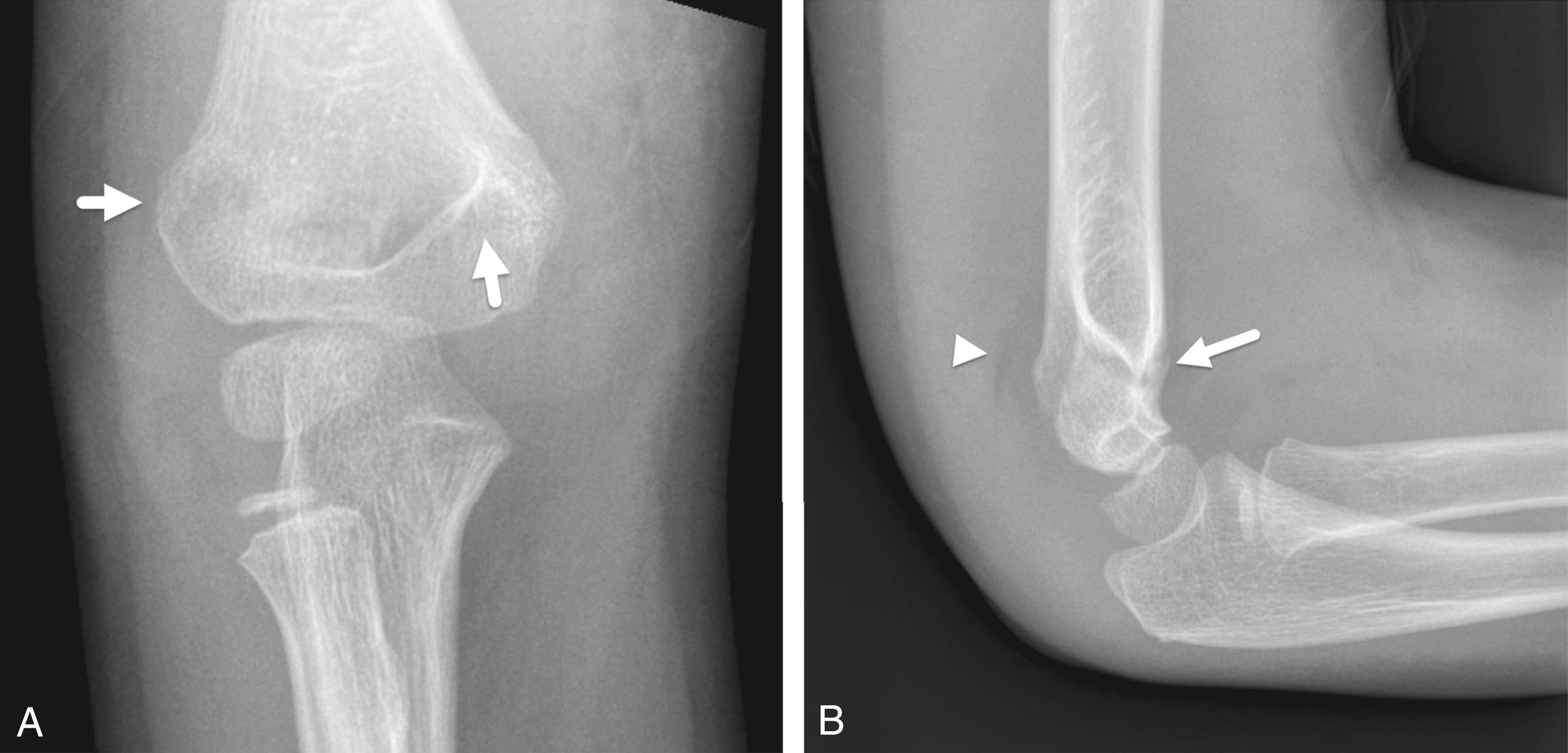
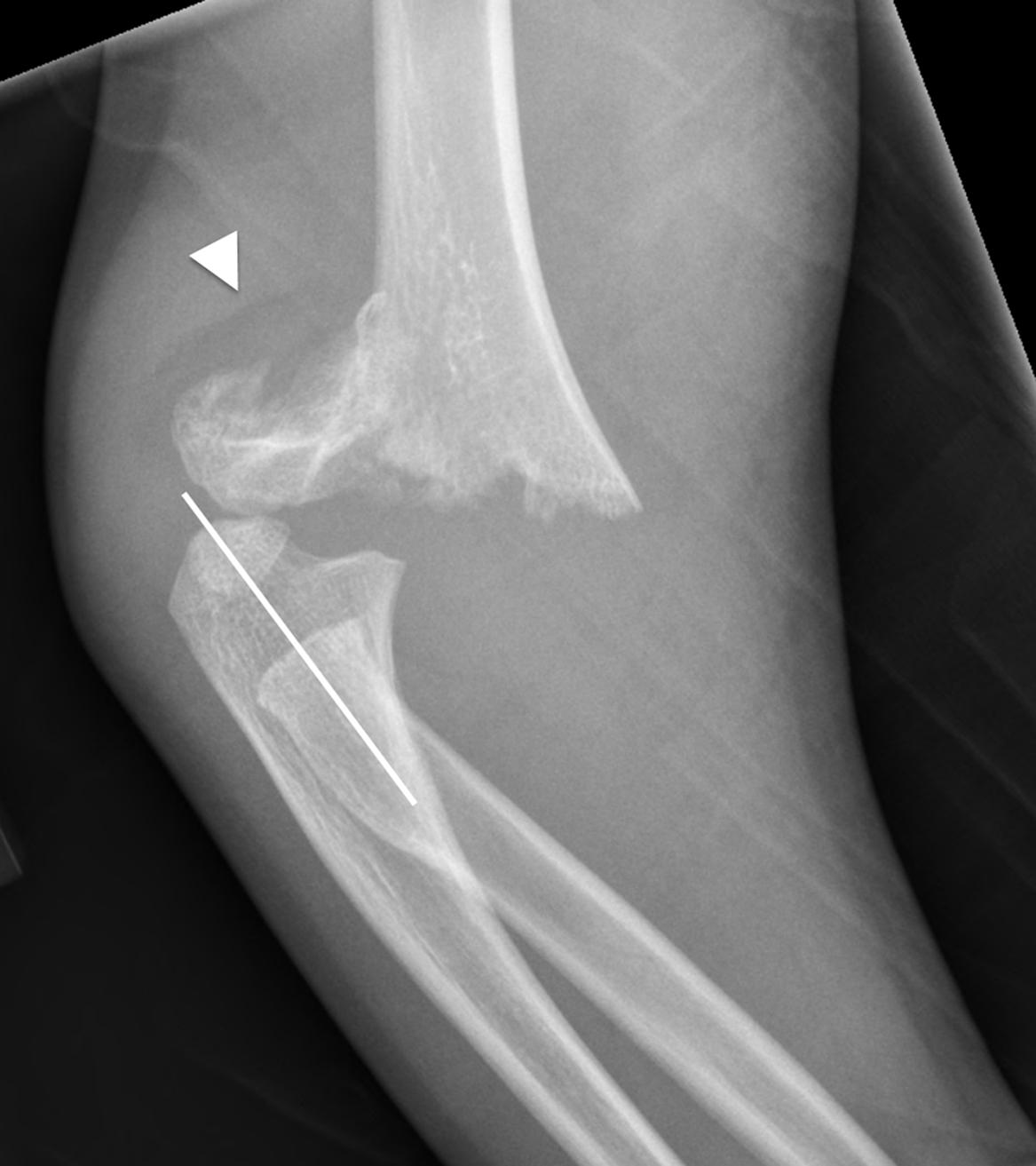
There is debate regarding the significance of a traumatic elbow effusion in the absence of a visualized fracture (see Fig. 7-26 ). It is often taught that a joint effusion is synonymous with an occult fracture. However, studies have shown that fractures are present in 50% or fewer cases. The point is moot because traumatic injury to the elbow is treated by splinting, whether a subtle fracture is identified or not. If pain persists, a repeat radiograph is obtained at the follow-up orthopedic appointment. If a fracture is present, signs of healing are evident.
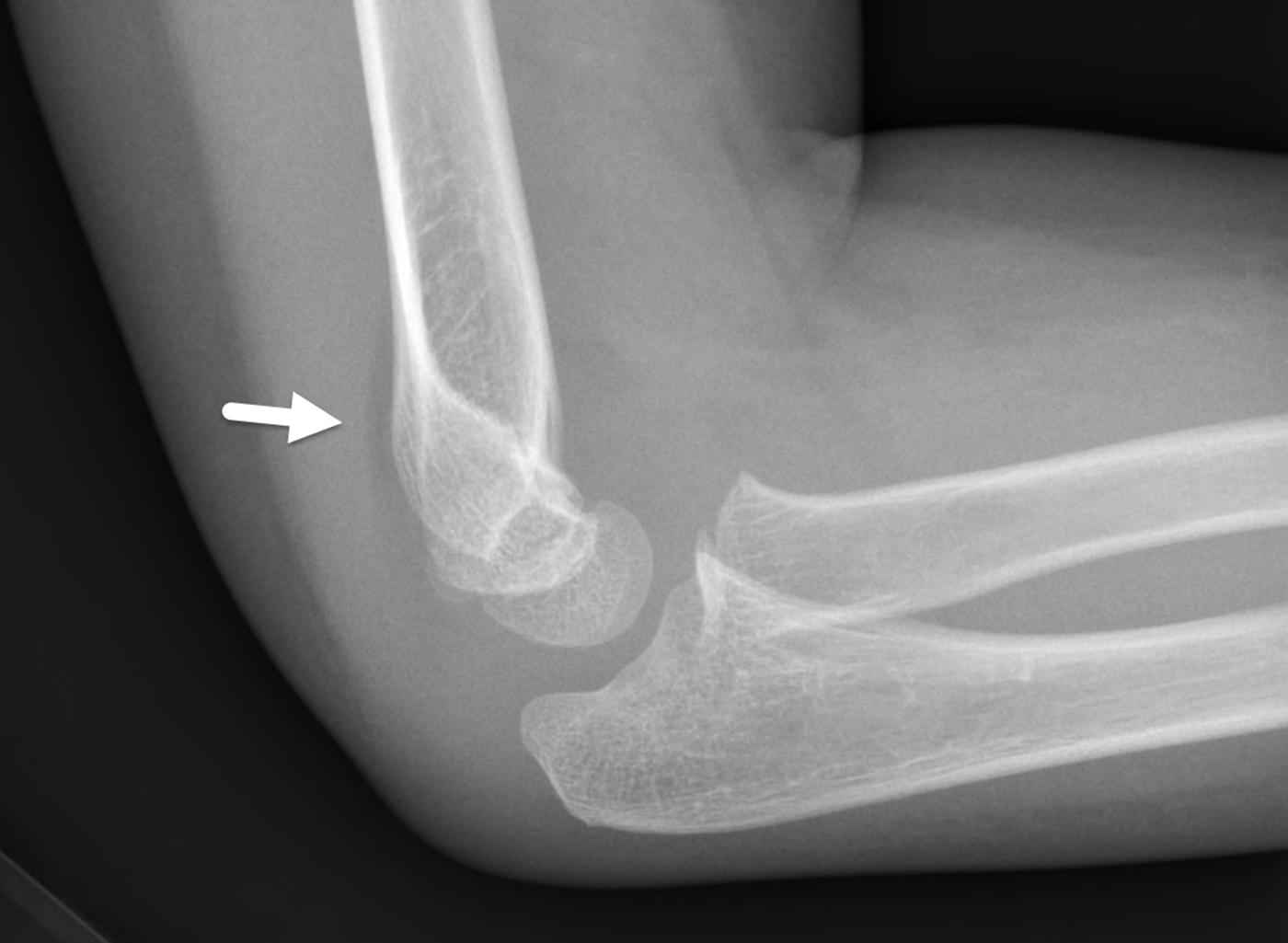
Other elbow injuries include fractures of the radial neck and lateral condyle ( Fig. 7-27 ) and avulsion of the medial epicondyle ( Figs. 7-28 and 7-29 ). When avulsed, the medial epicondyle may become displaced and even entrapped within the elbow joint (see Fig. 7-29 ). It is important to know the predictable order of maturity of the elbow ossification centers so that a displaced medial epicondyle is not missed. The order can be remembered by the mnemonic CRITOE (capitellum, radial head, internal [medial] epicondyle, trochlea, olecranon, external [lateral] epicondyle).
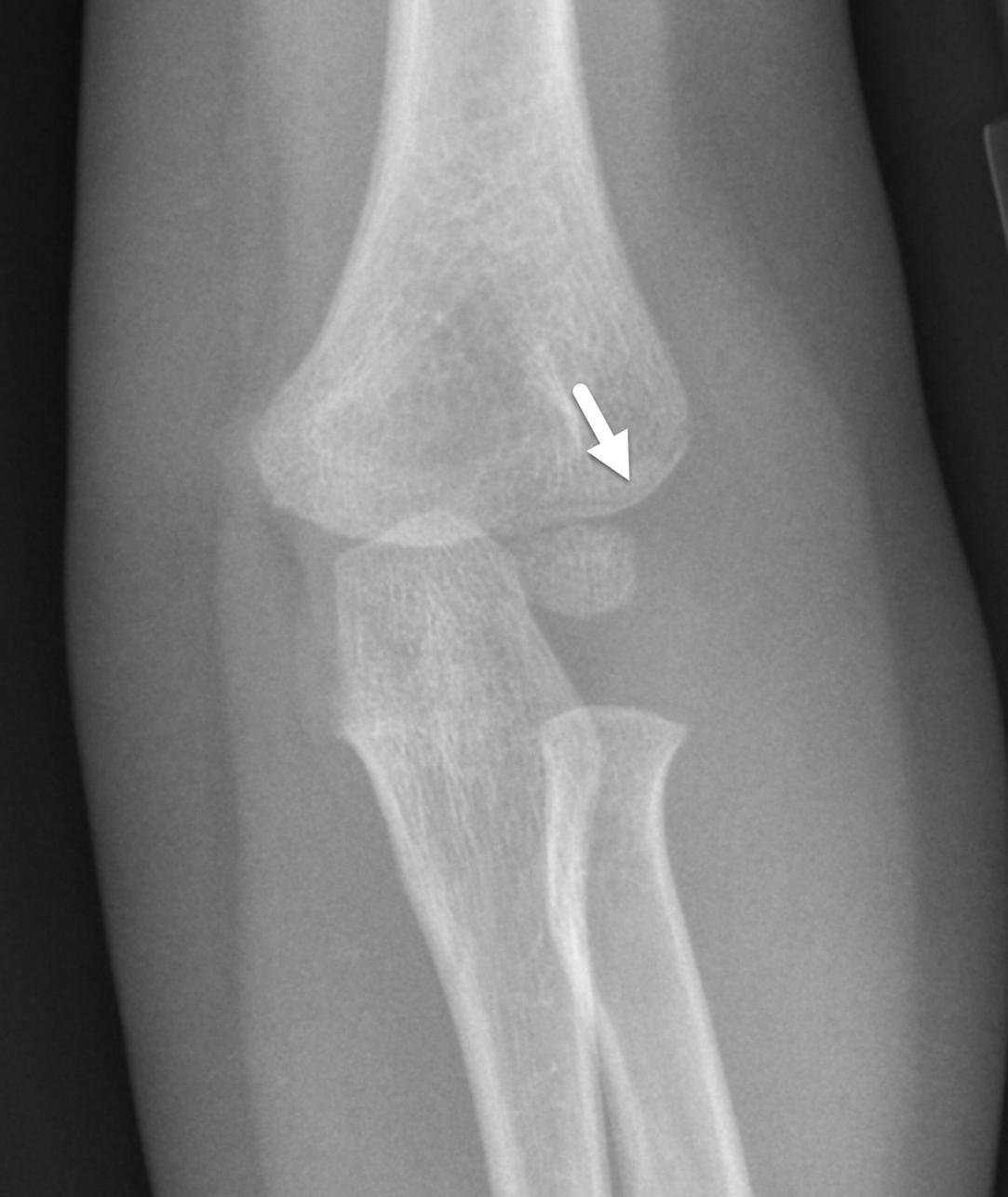
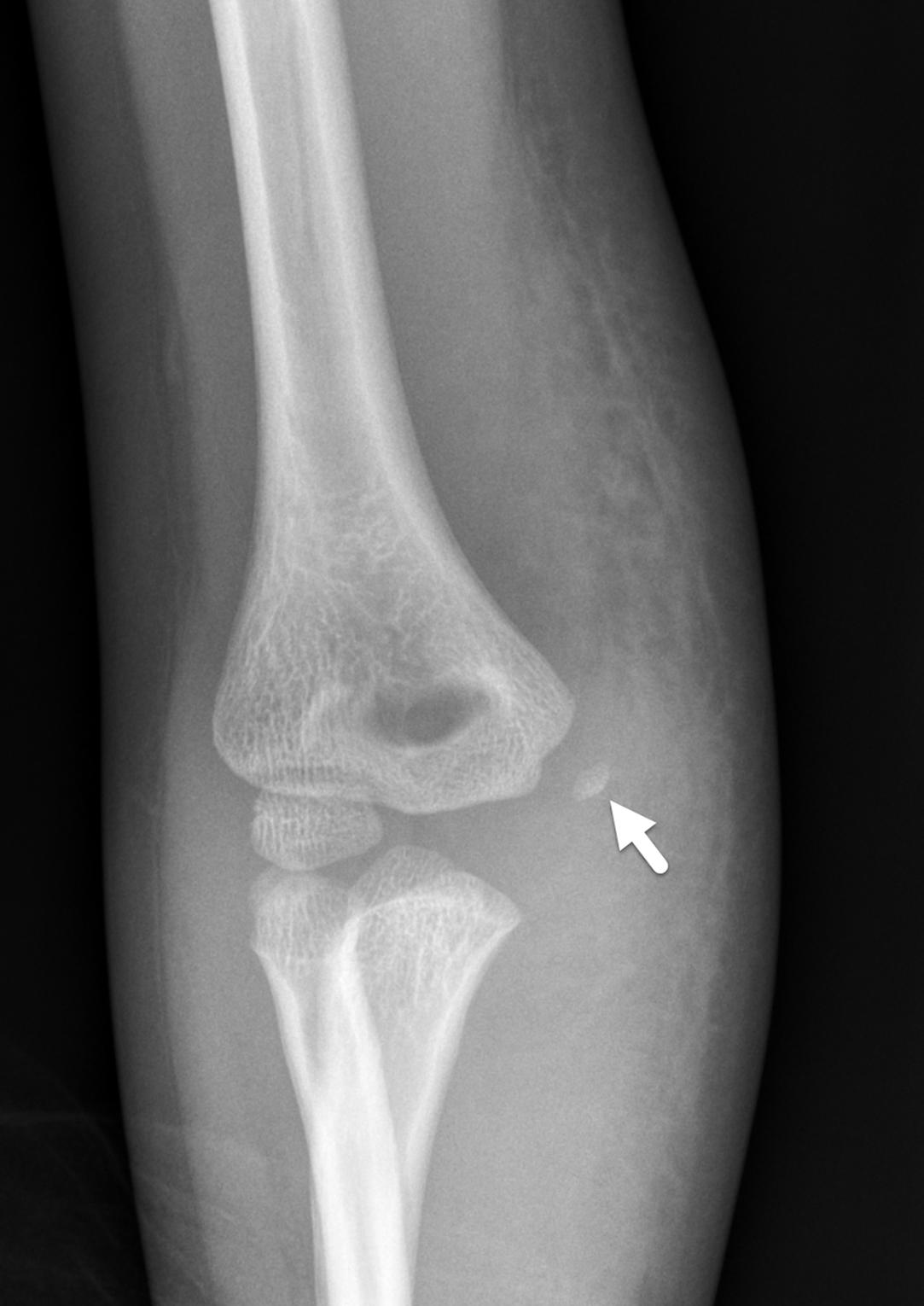
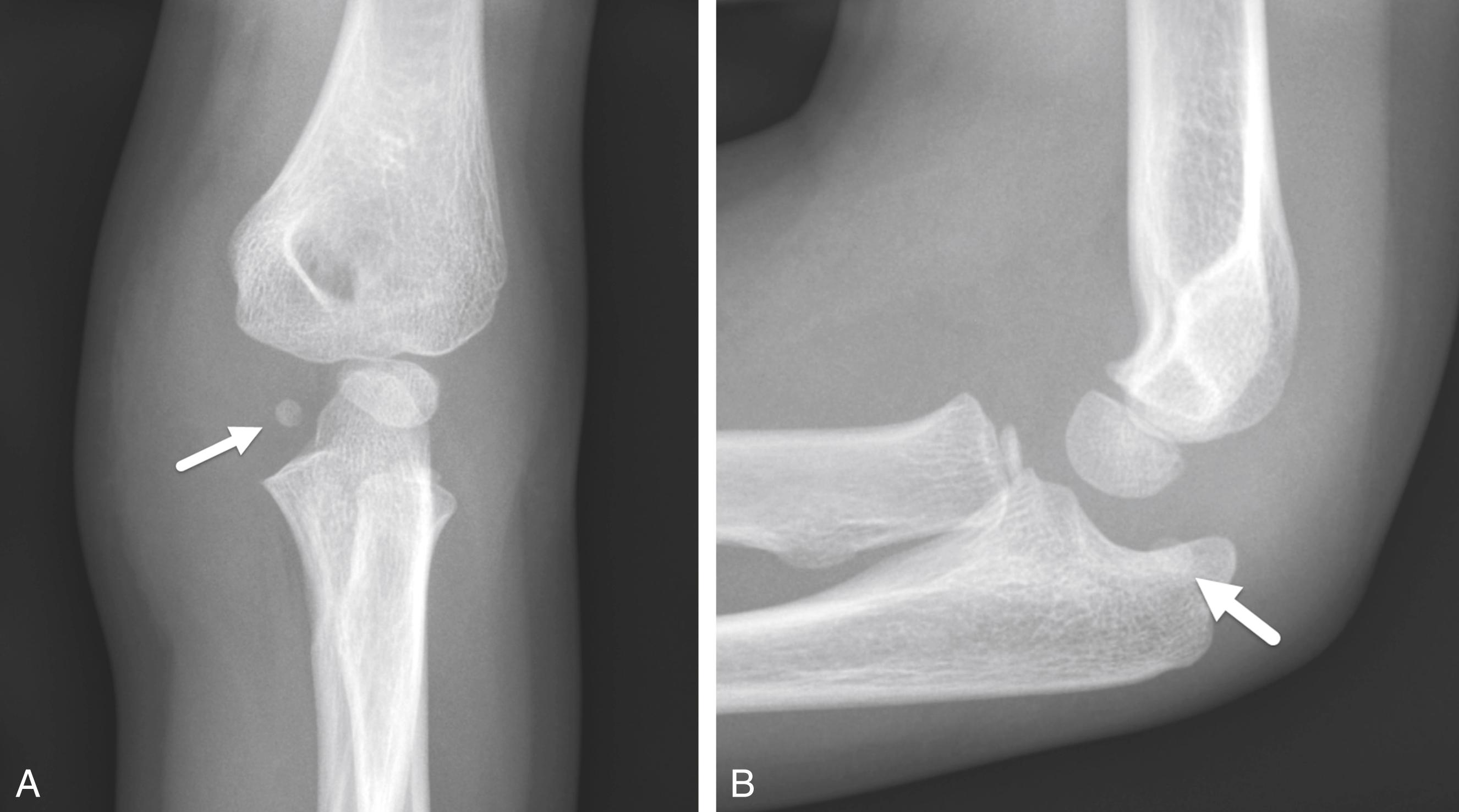
Whenever there is a fracture of the forearm, it is important to evaluate the radial-capitellar joint for potential dislocation of the radial head. The radial head should align with the capitellum on both the anteroposterior (AP) and lateral views. If it does not, radial head dislocation should be suspected ( Fig. 7-30 ). When a radiocapitellar dislocation is present, the entire forearm should be imaged to evaluate for a Monteggia fracture. Monteggia fractures represent a fracture-dislocation injury with dislocation of the head of the radius and an associated fracture of the ulnar diaphysis (see Fig. 7-30 ).
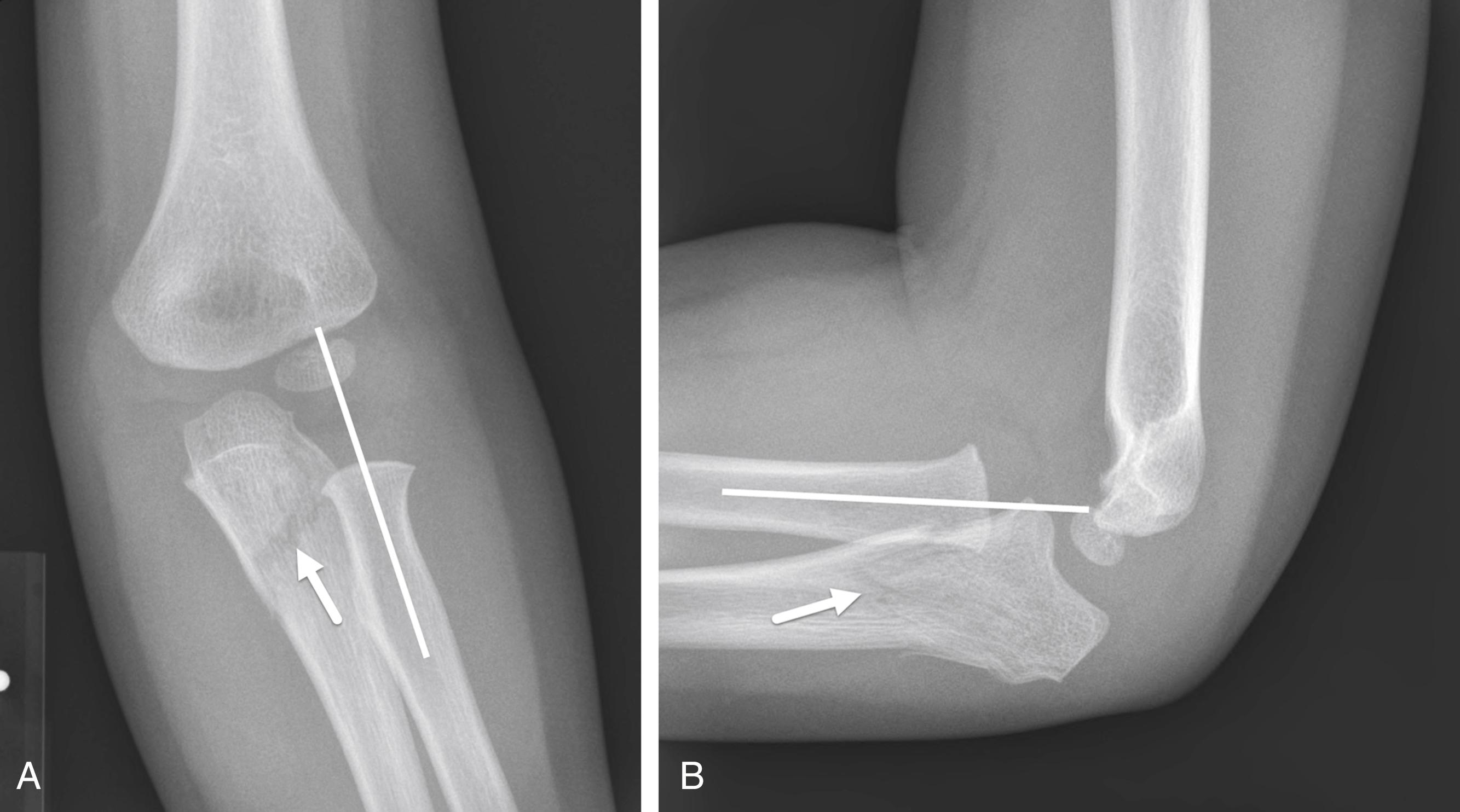
Distal humerus physeal separation ( Fig. 7-31 ) is a unique fracture seen exclusively in young children. In young infants, this represents a Salter–Harris type I fracture occurring through the distal humerus physeal cartilage. Because the fracture can occur before the capitellum begins to ossify, the fracture can be difficult to detect. On radiograph, there is usually posterior and ulnar displacement of the radius and ulna in relation to the distal humerus. This causes the forearm to not be aligned with the distal humerus. The fracture is associated with birth trauma in neonates and child abuse in older infants.
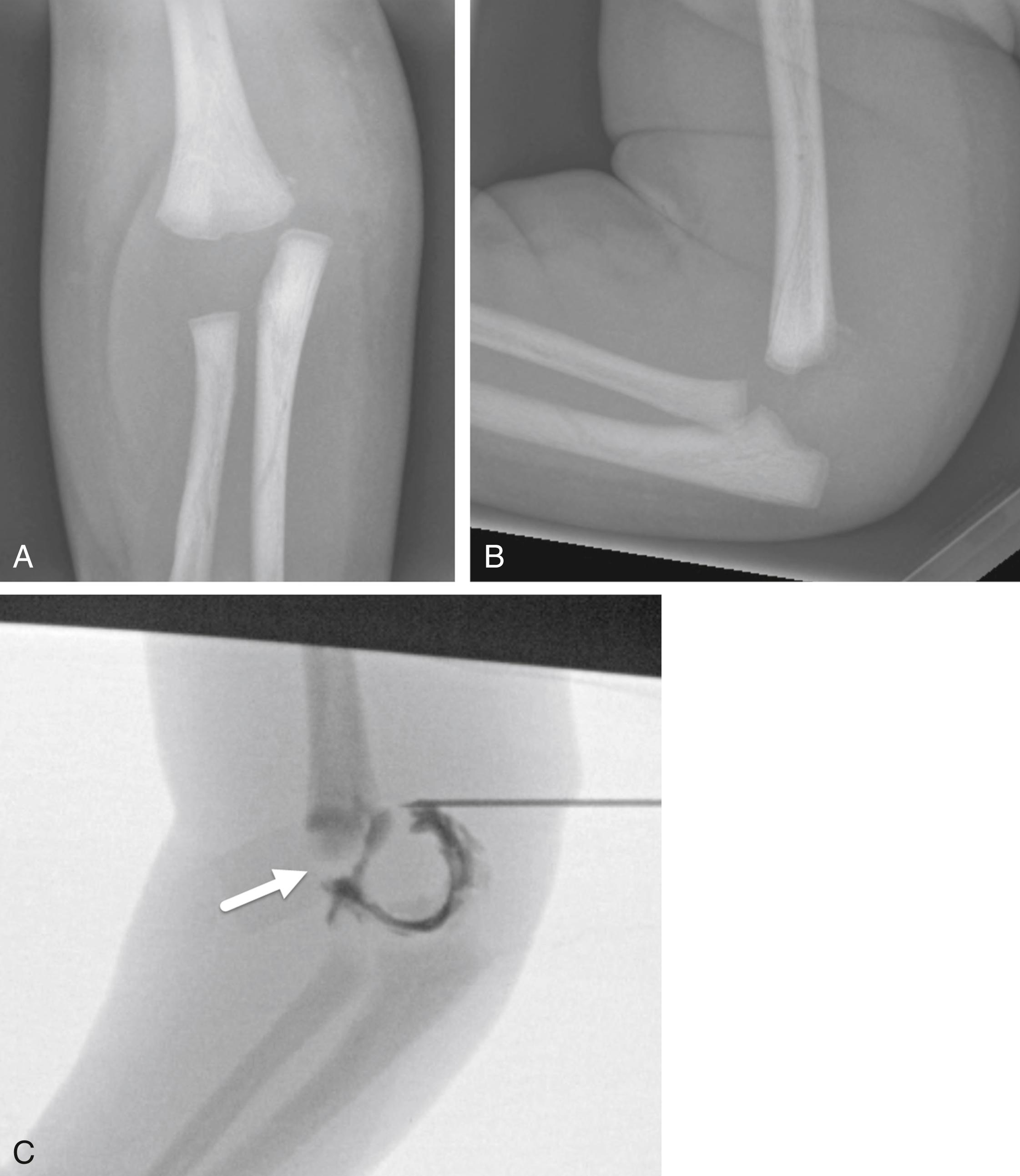
The ankle is a commonly injured joint due to a combination of inversion and eversion injuries with weight bearing. There are two common fractures that are unique in adolescents, triplane fractures, and juvenile Tillaux fractures. As the name implies, a triplane fracture occurs in three planes: the coronal plane through the tibial metaphysis, the transverse plane through the physis, and the sagittal plane through the epiphysis ( Fig. 7-32 ). Because the fracture extends through the metaphysis and epiphysis, this is a Salter–Harris type IV fracture. Triplane fractures occur in adolescents in whom the growth plate is beginning to close. The radiologist should measure the degree of distraction of the fracture fragment as internal fixation is performed if there is more than 2-mm displacement. Often a CT is performed to evaluate the fracture and the amount of distraction more accurately. Fibular fractures are present approximately half of the time.
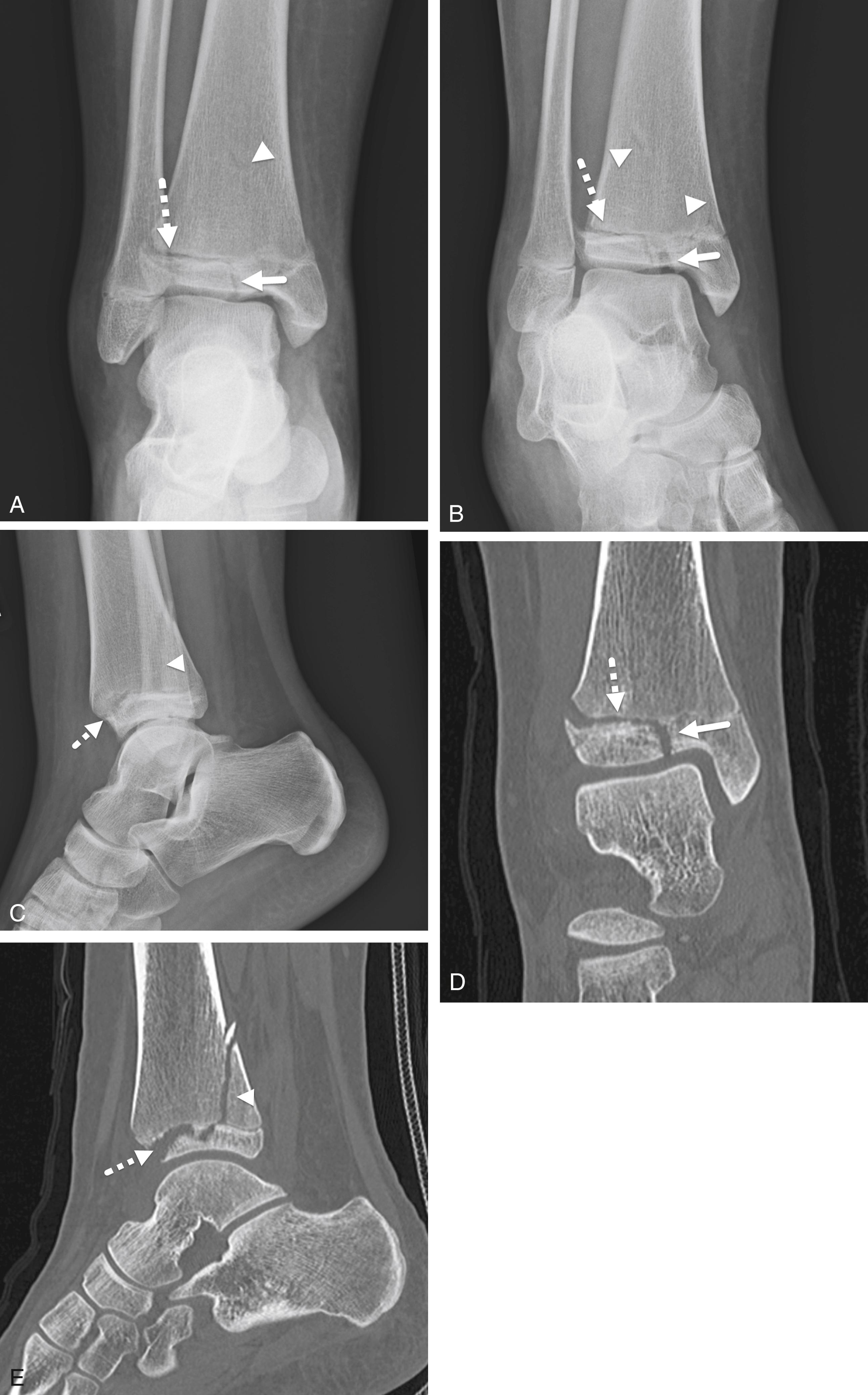
Juvenile Tillaux fractures are Salter–Harris type III fractures of the distal tibia. Like triplane fractures, they occur in adolescents in whom the growth plate is beginning to close. The fracture occurs because the medial tibial physis closes before the lateral physis. The differences in structural stability lead to this fracture pattern when there is abduction and external rotation of the ankle. On X-ray, there is a fracture line through the distal tibial epiphysis and widening of the medial aspect of the ankle mortise ( Fig. 7-19 ). CT is performed to evaluate the amount of fracture distraction. Like triplane fractures, orthopedic surgeons will perform internal fixation if the fracture is distracted by more than 2 mm.
There are several fractures referred to as toddler fractures. The most common of these is a nondisplaced oblique or spiral fracture of the tibia diaphysis ( Fig. 7-33 ). It is often difficult to determine the vertical extent of the fracture. However, toddler fractures of the tibia can extend to the articular surface at the ankle. The radiologist should have a high index of suspicion to describe any vertically oriented lucency as extension of the fracture. Toddler fractures are relatively common and occur when a child first begins to walk. Most children present with refusal to bear weight on that extremity. Oblique views often demonstrate the fracture better than do frontal or lateral views. When diagnosing this fracture, it is important to look at the patient's age because a spiral fracture in a child who is not yet walking can be a fracture of abuse. Other types of toddler fractures include stress-type fractures involving the calcaneus or cuboid ( Figs. 7-34 and 7-35 ).
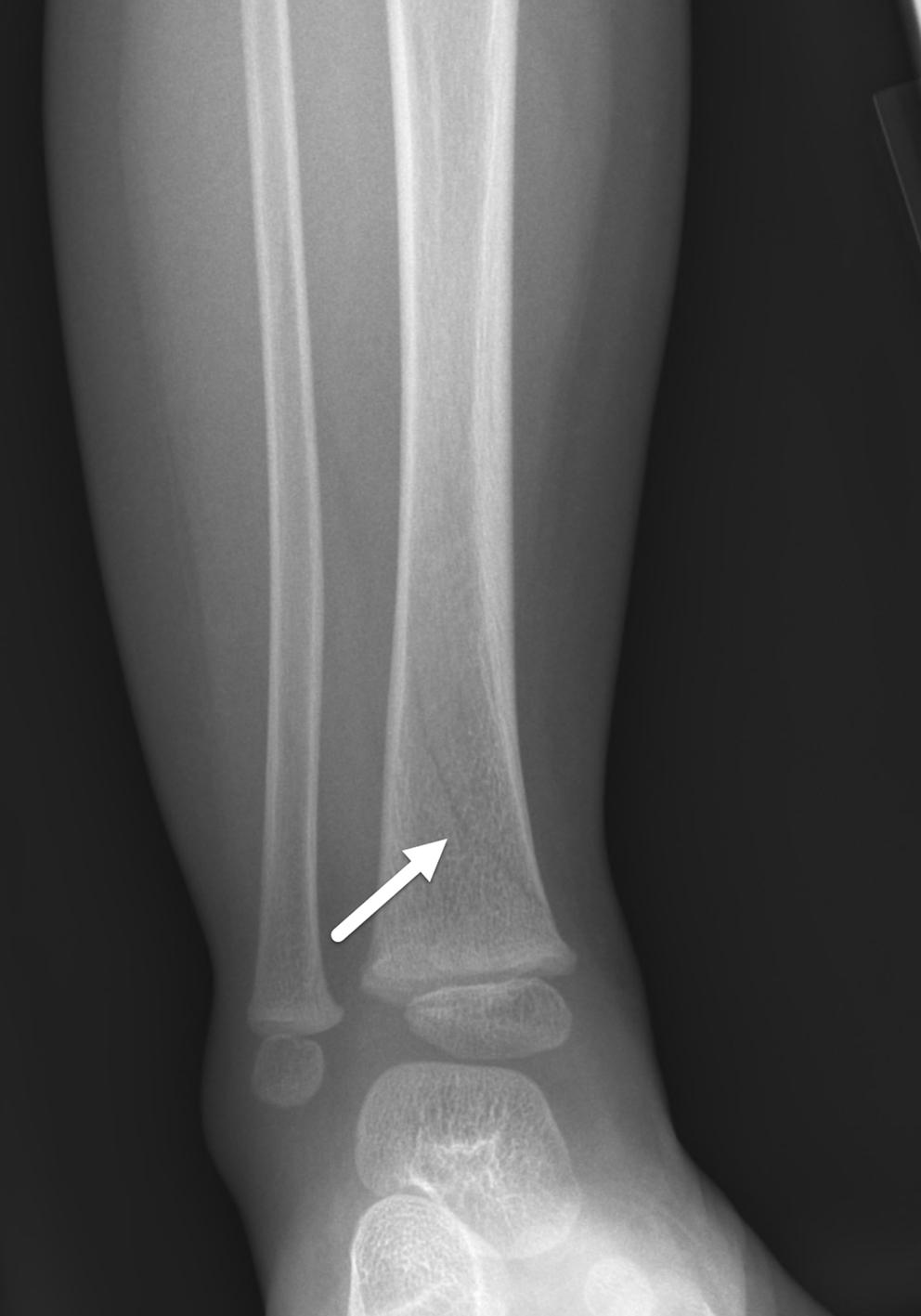
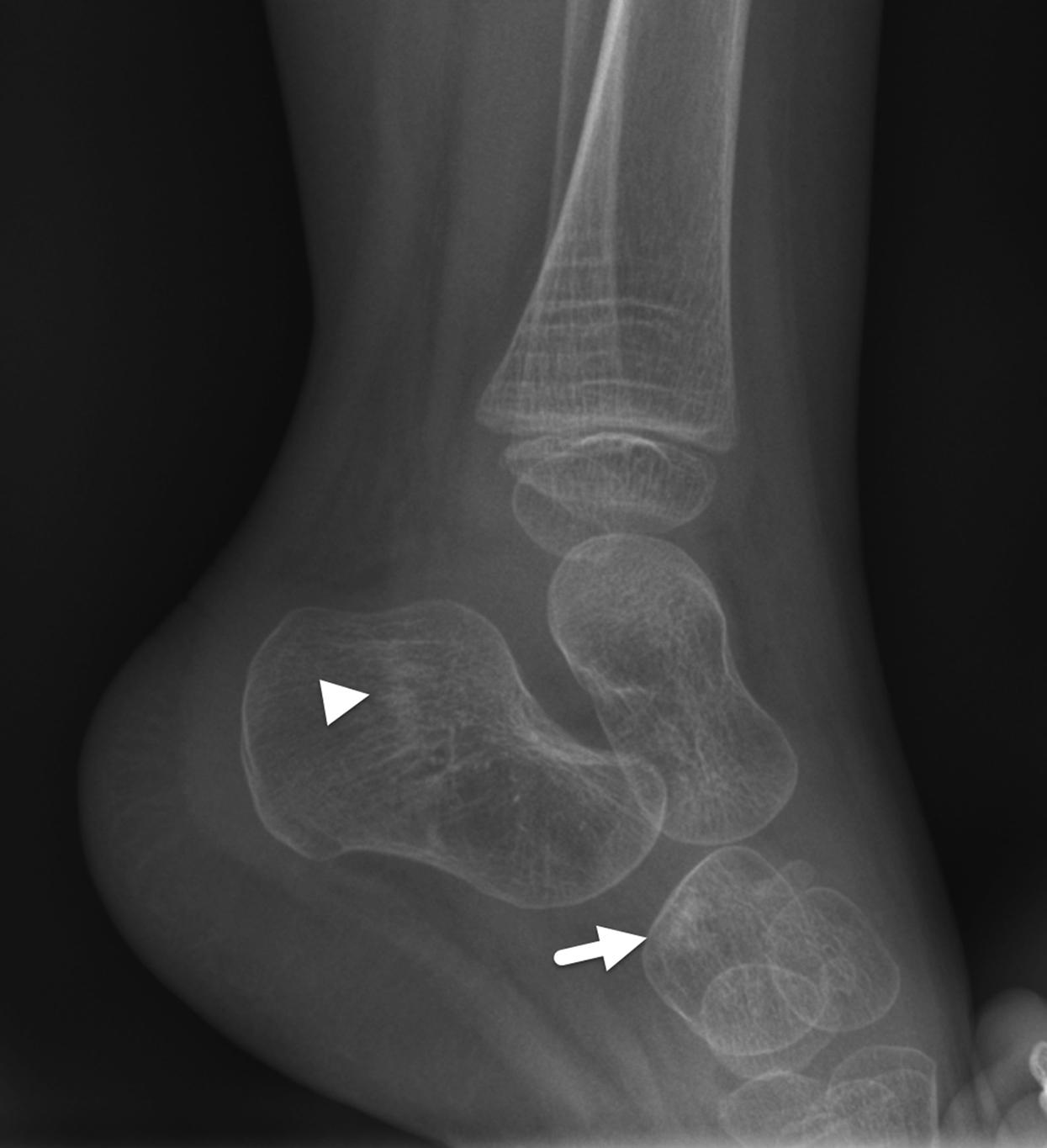
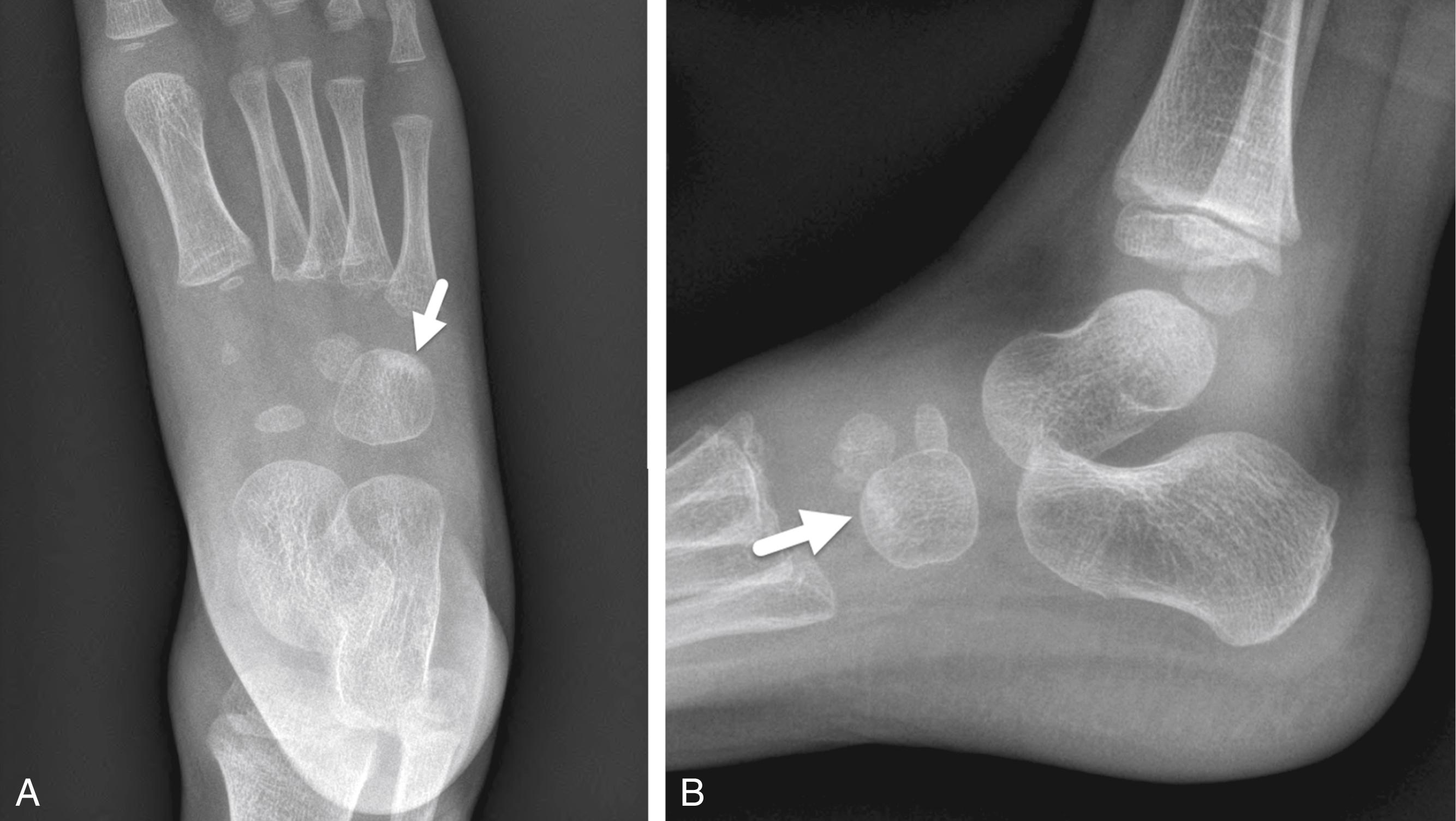
An avulsion fracture is a structural failure of bone at a tendon or aponeurotic insertion. Adolescents are prone to avulsion fractures because of a combination of their strength, their activity or participation in sports, and their immature, growing apophyses. Avulsion fractures occur because the growing apophysis and its associated physis have less structural integrity than the attaching tendon. The sites of insertion of muscles capable of generating great forces are most predisposed to avulsion injuries.
Radiologists may encounter findings of chronic avulsion when patients are imaged for pain or incidentally when imaging is performed for other reasons. The irregularity and periostitis that can be associated with chronic avulsions should not be misinterpreted as suspicious for malignancy. The most common sites of avulsion occur within the pelvis, where muscles of the abdominal wall and lower extremities attach. Common sites of pelvic apophyseal avulsions and their associated muscular attachments include the iliac crest (transversalis, internal oblique abdominalis, external oblique abdominalis; Fig. 7-36 ); anterior superior iliac spine (sartorius; Fig. 7-37 ); anterior inferior iliac spine (rectus femoris; Fig. 7-38 ); ischial apophysis (hamstring muscles: biceps femoris, gracilis, semimembranosus, semitendinosus; Fig. 7-36 ); and lesser trochanter (iliopsoas). The radiographic findings of avulsion injuries include displacement of the ossified apophysis from its normal position and variable, often exuberant periosteal new bone formation with healing.
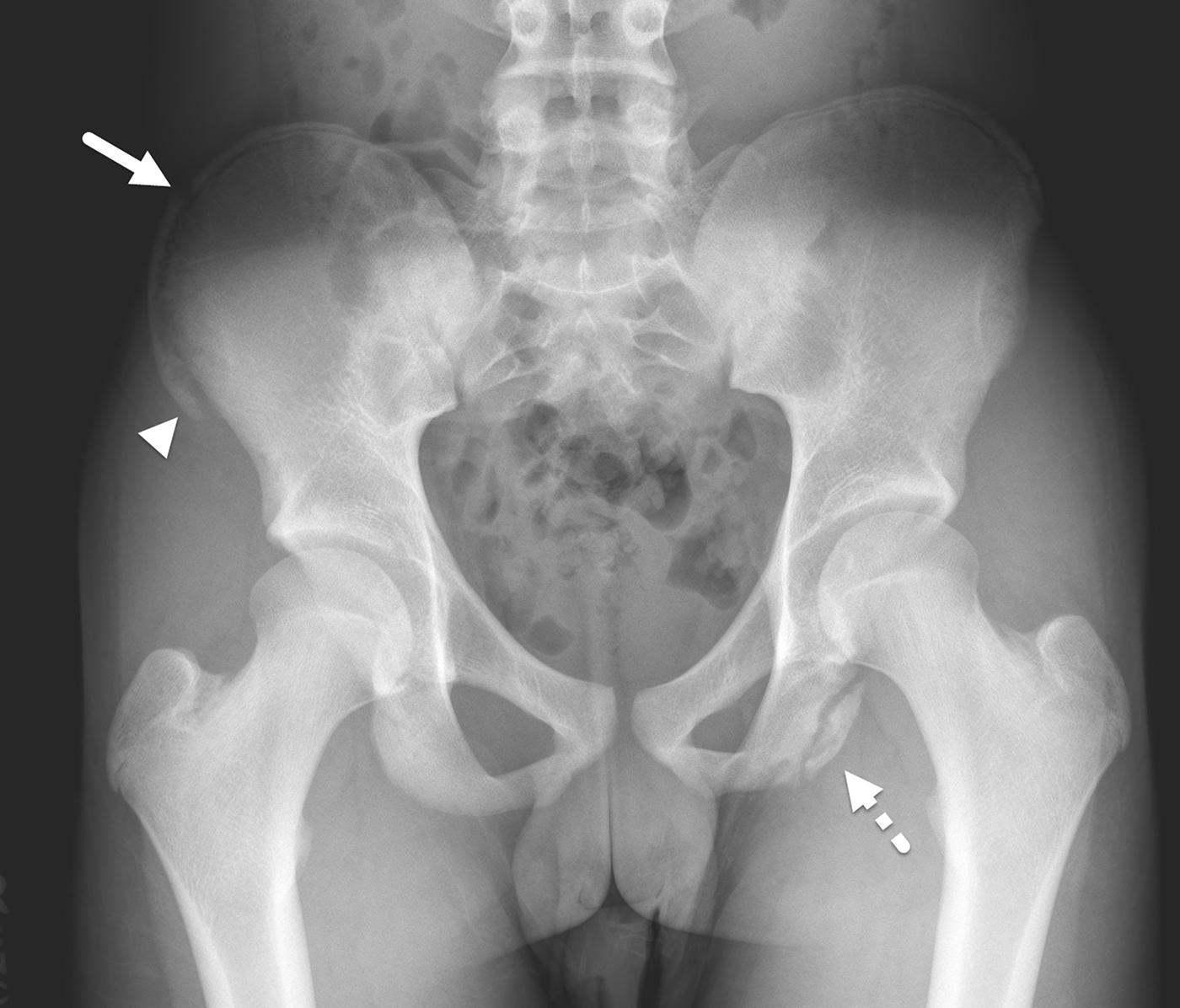
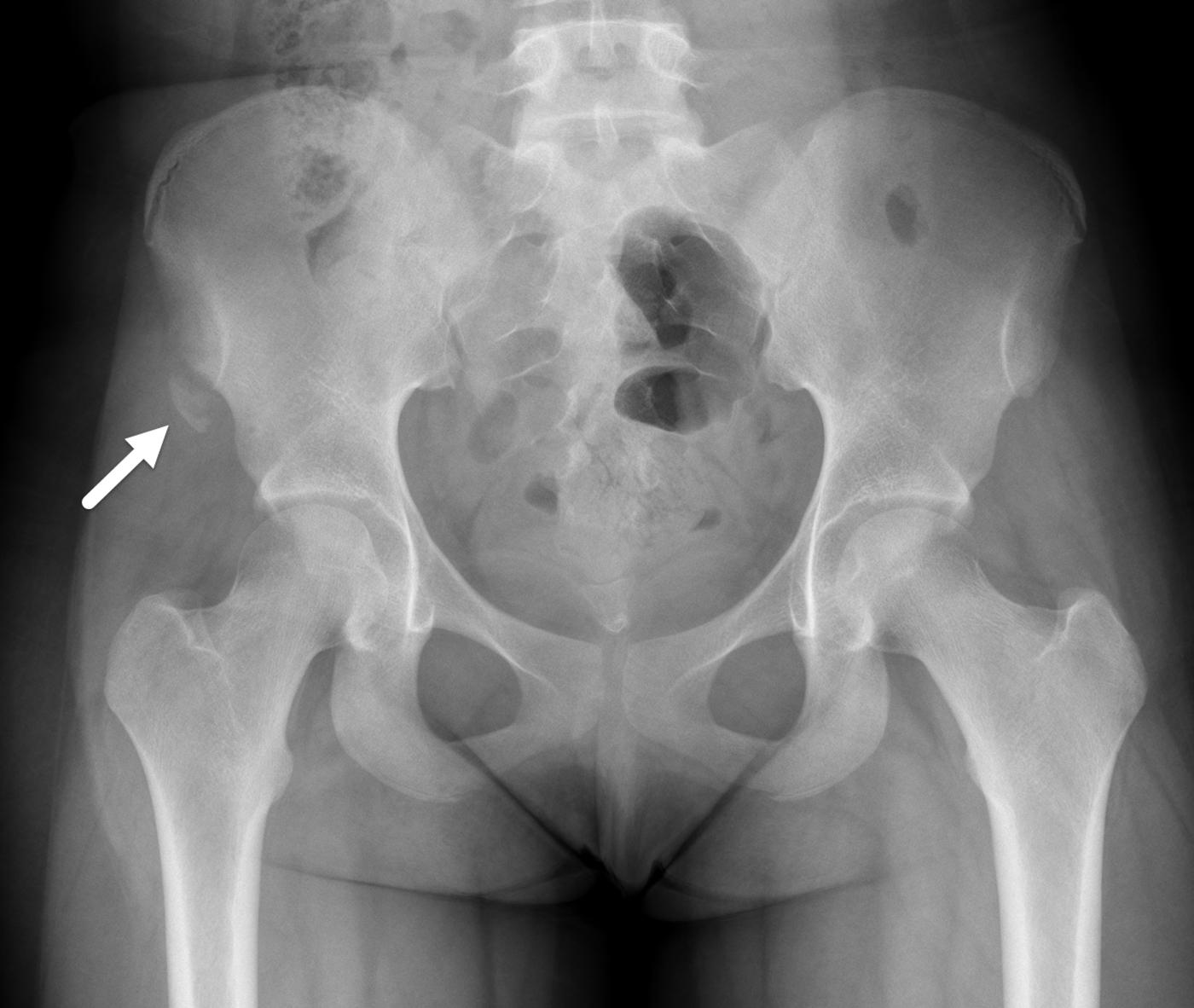

When involving a joint, avulsion fractures occur at the cortical insertion site of a ligament or tendon. The knee is the joint most commonly associated with an avulsion fracture. Many of these injuries occur exclusively in children and adolescents. Common sites of knee avulsion fractures and their associated tendinous or ligamentous attachments include the anterior medial tibial spine (anterior cruciate ligament; Fig. 7-39 ); lateral tibial rim, also known as a Segond fracture (lateral collateral ligament; Fig. 7-40 ); fibular head (conjoined tendon with biceps femoris); tip of the fibular head (arcuate ligament); inferior pole of the patella, also known as the patellar sleeve (proximal patellar tendon; Figs. 7-41 and 7-42 ); and tibial tubercle (distal patellar tendon Fig. 7-43 ). Many of these injuries present with sudden pain and a joint effusion. MRI is often indicated because these injuries are associated with other internal derangement.
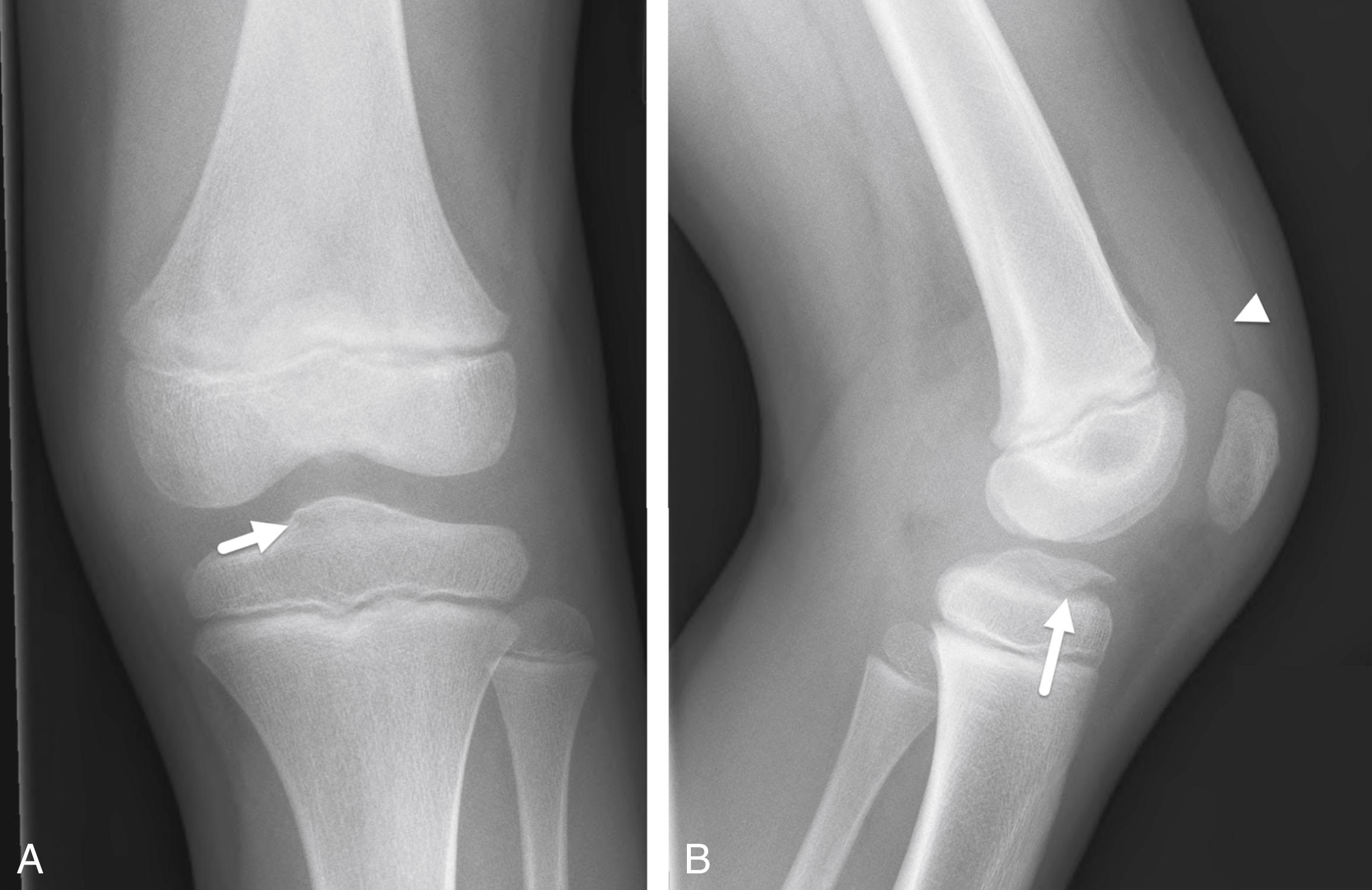
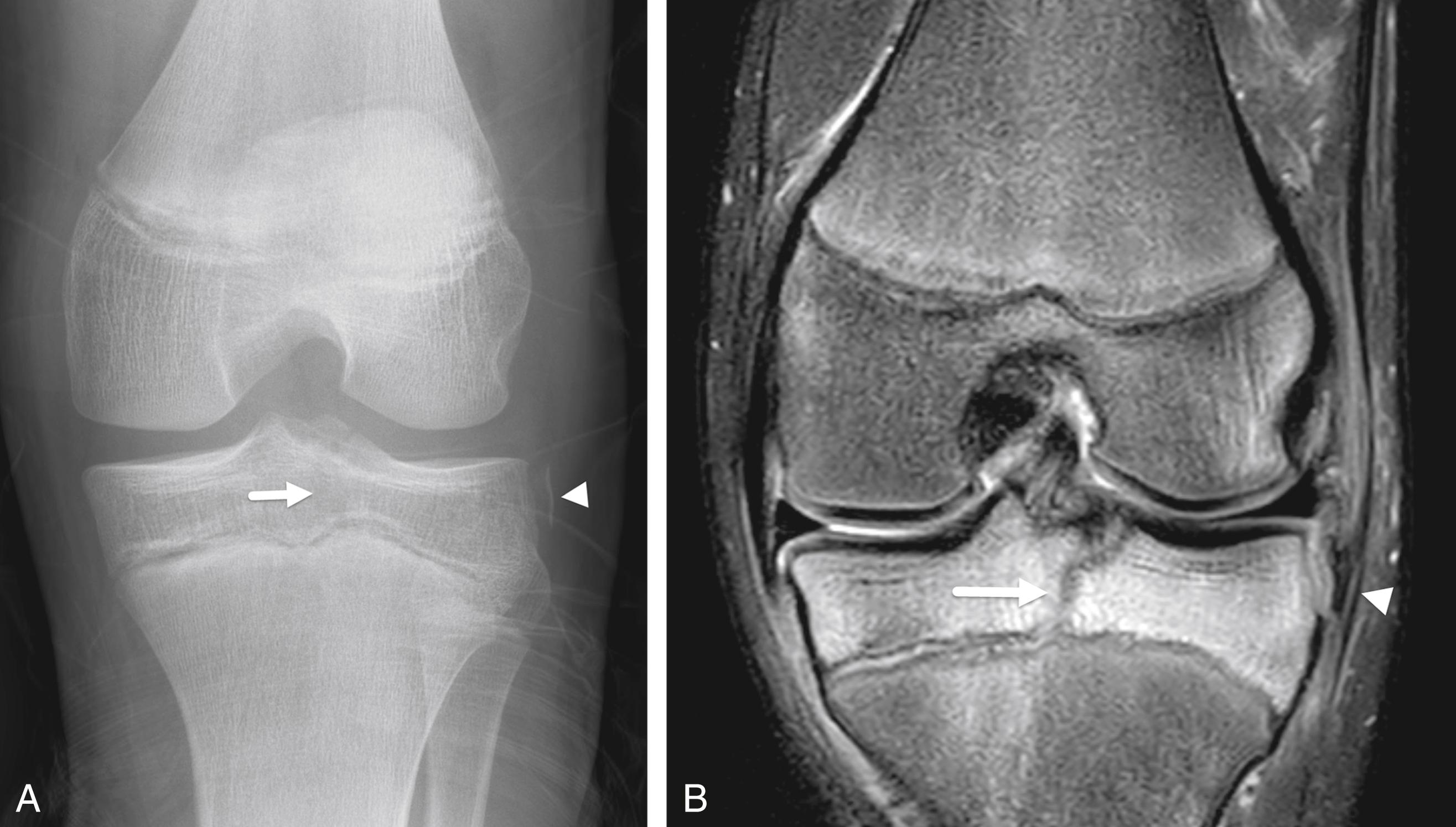

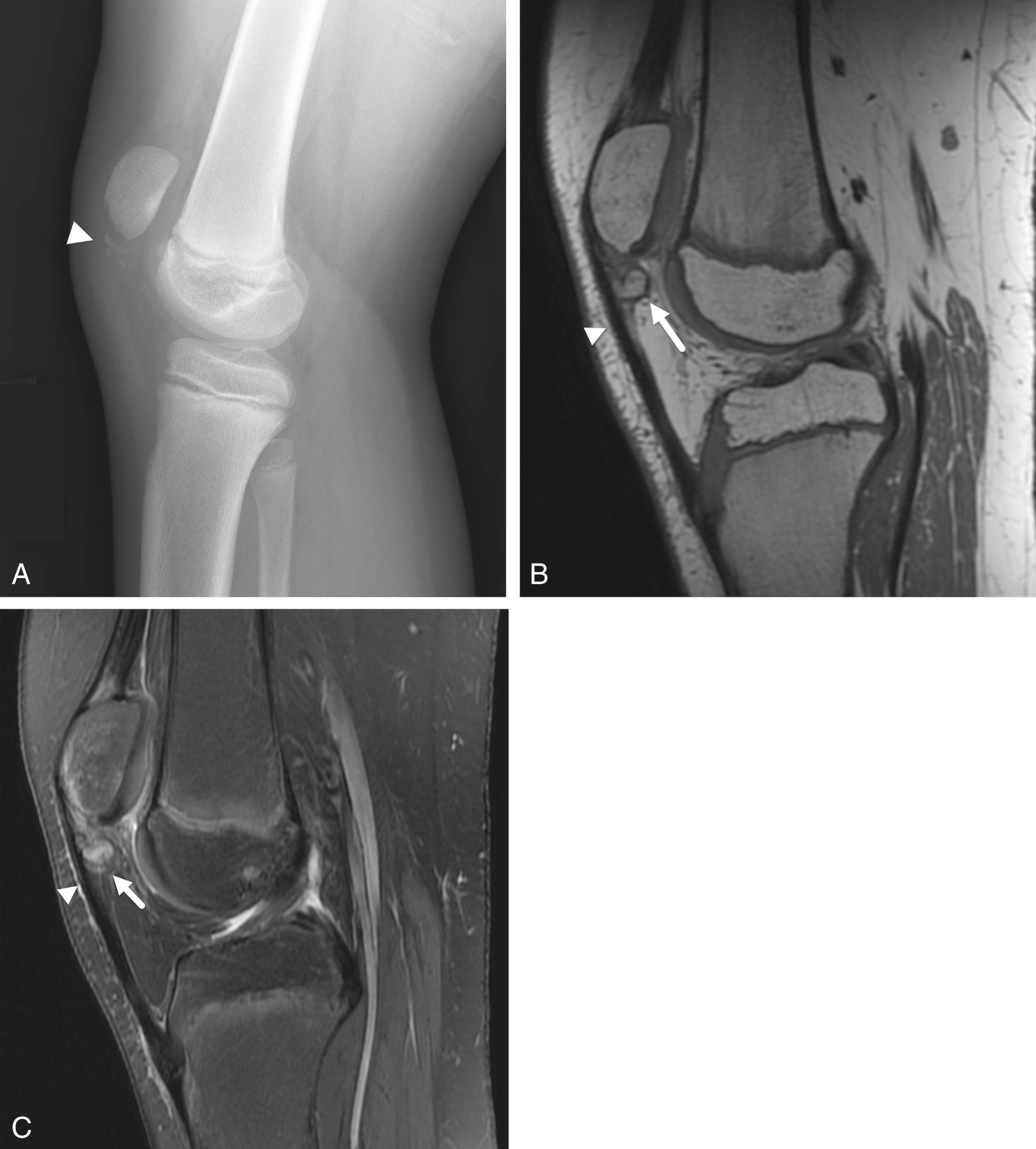

Chronic fatigue or strain injuries are common in the adolescent knee and can lead to apophysitis. Apophysitis of the inferior pole of the patella at the origin of the patellar tendon is called Sinding–Larsen–Johansson syndrome ( Fig. 7-44 ). It occurs most commonly in children between 10 and 14 years of age. Symptoms include localized pain and swelling over the inferior aspect of the patella associated with restricted knee motion. Radiography demonstrates irregular bony fragments at the inferior margin of the patella, associated with adjacent soft tissue swelling and thickening and indistinctness of the patellar tendon. Apophysitis of the tibial tuberosity at the patellar tendon insertion is referred to as Osgood–Schlatter disease ( Fig. 7-45 ). It is a common disorder that most often affects active adolescent boys. Symptoms include pain and swelling over the tibial tuberosity. Radiography demonstrates fragmentation of the tibial tuberosity, associated adjacent soft tissue swelling, and thickening and indistinctness of the patellar tendon.
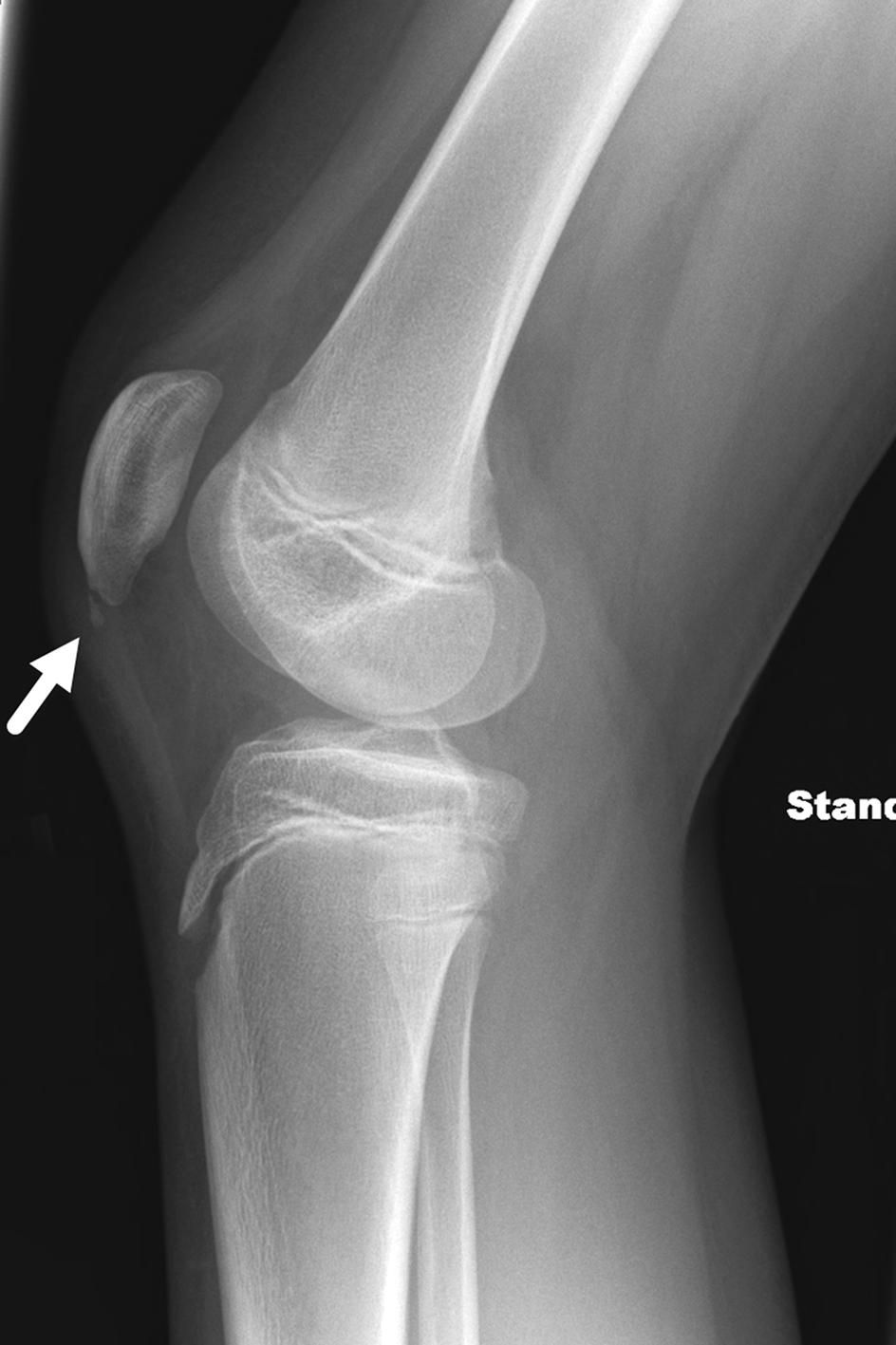
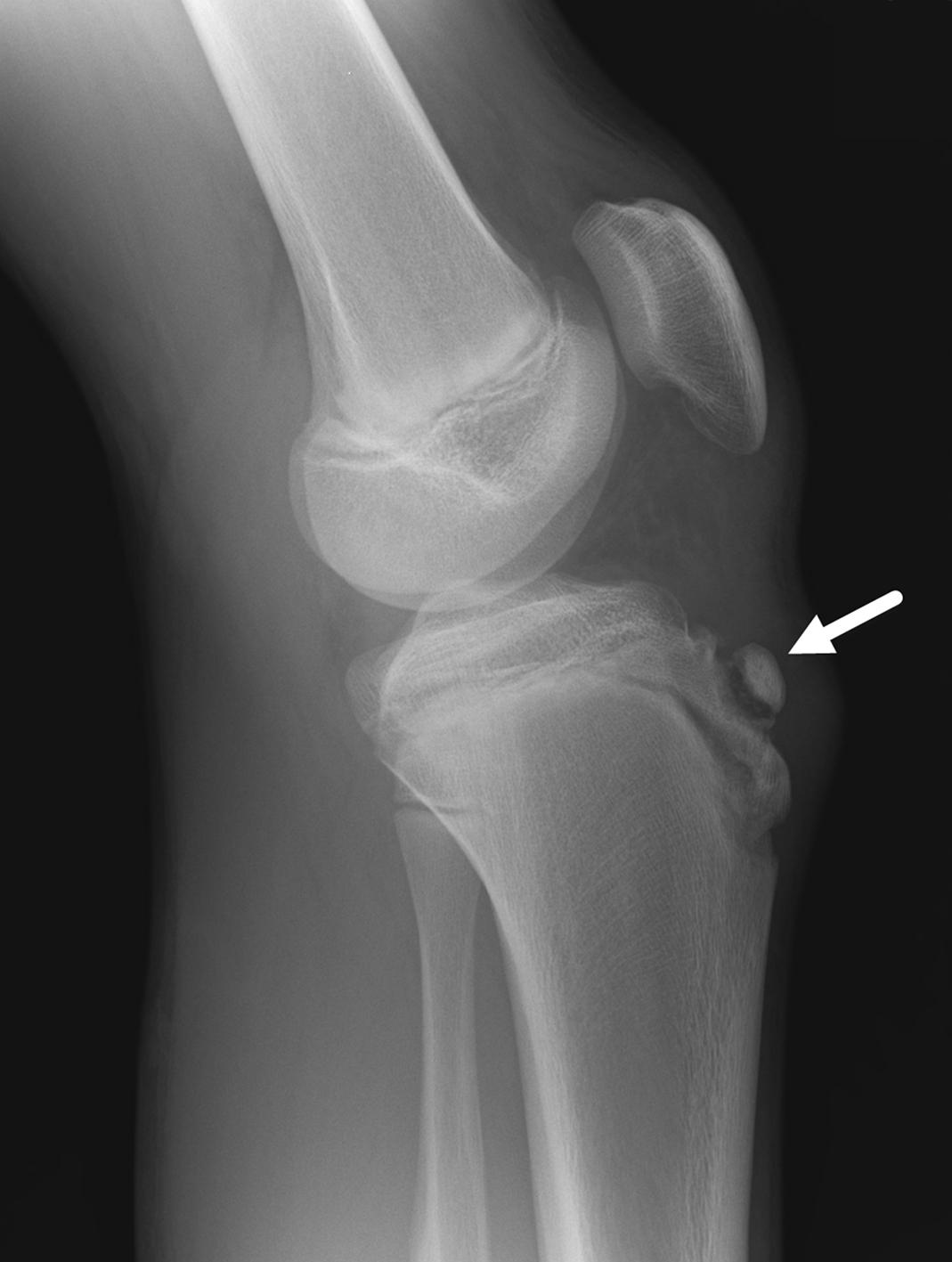
The normal apophysis of the fifth metatarsal is frequently mistaken for an avulsion fracture. This mistake is made for two reasons. First, it is common for children with a foot injury to present with lateral foot pain. Second, avulsion fractures of the proximal fifth metatarsal, the so-called pseudo-Jones fracture, are common. The apophysis can be distinguished from a fracture based on the orientation of the lucency. The normal apophysis of the fifth metatarsal extends parallel to the long axis of the metatarsal ( Figs. 7-46 and 7-47 ). Avulsion fractures of the fifth metatarsal occur as a result of inversion of the foot in plantar flexion such as when climbing steps. These fractures extend perpendicular to the long axis of the fifth metatarsal and may extend into the tarsal/metatarsal joint.
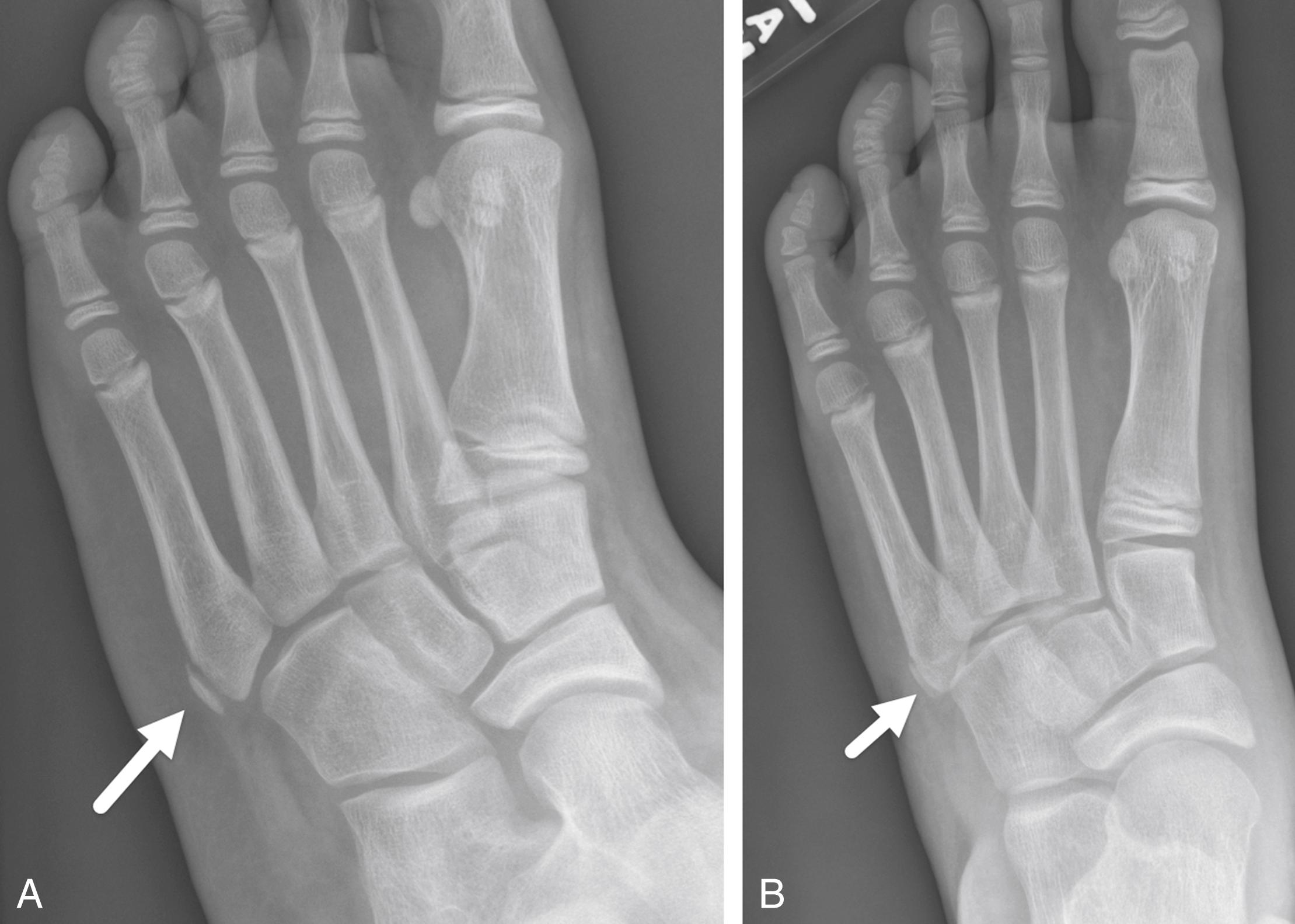
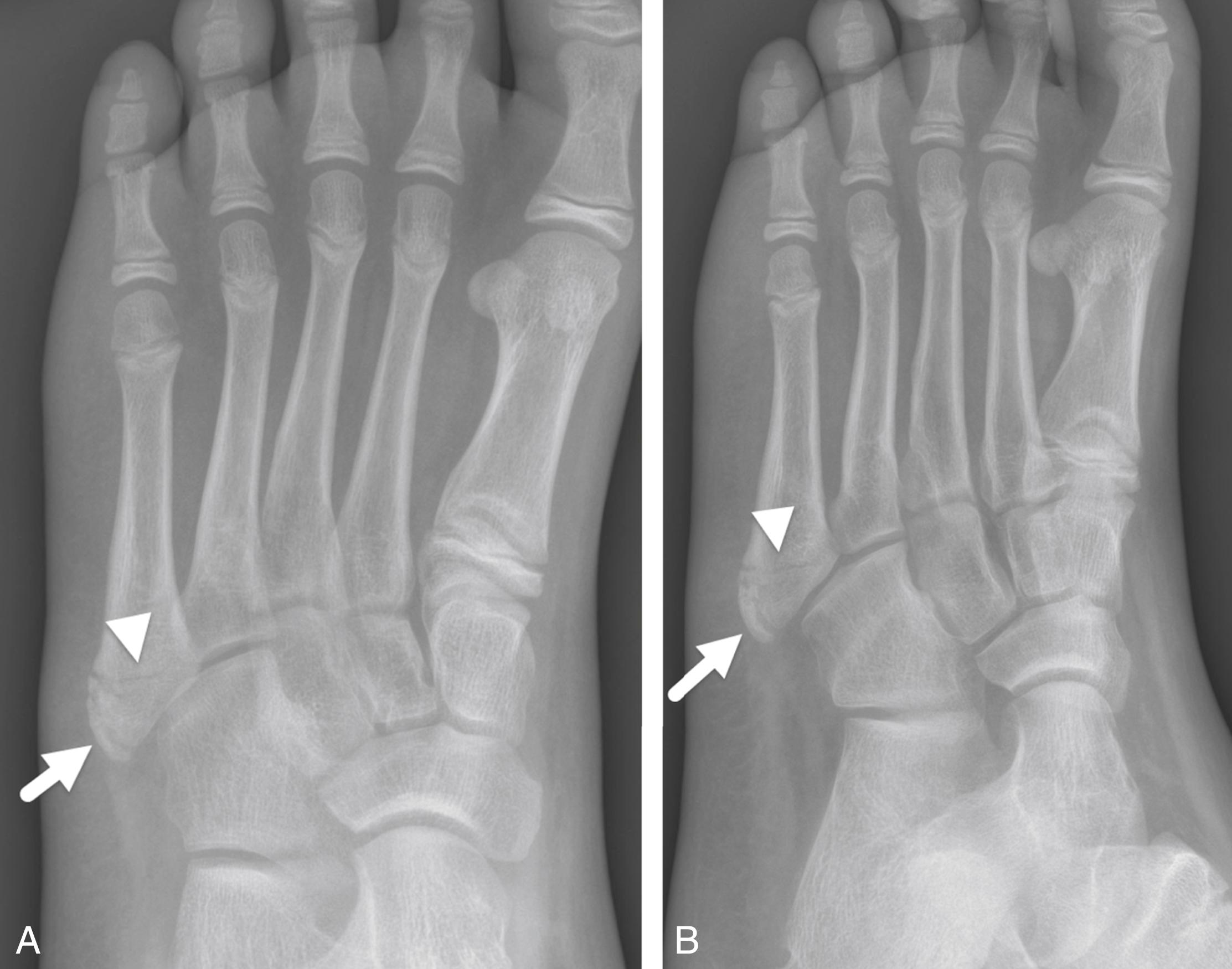
Child abuse, also referred to as the less accusatory term, nonaccidental trauma , is unfortunately common. According to data from the US Department of Health and Human Services, 678,000 children were abused and 1770 killed in 2018 in the United States ( https://www.acf.hhs.gov/sites/default/files/cb/cm2018.pdf ). Most abused children are less than one year of age and almost all are less than six years of age. When clinical or imaging findings are suspicious for potential abuse, a radiographic skeletal survey is typically obtained. The purpose of the skeletal survey is to document the presence of findings of abuse. In young children, a head CT is often performed to identify intracranial signs of abuse. Other tests sometimes used include a repeat skeletal survey after approximately two weeks to look for healing injuries not seen on the initial skeletal survey, skeletal scintigraphy, abdominal CT, and MRI of the brain. The identification and reporting of findings of child abuse by the radiologist is an important task.
The radiographic findings of abuse vary in their specificity. One of the highly specific findings is the presence of posterior rib fractures occurring near the costovertebral joints ( Fig. 7-48 ). These are thought to occur when an adult squeezes an infant's thorax. Such rib fractures may be subtle before development of callus formation. The evaluation for rib fractures should be a routine part of the evaluation of the chest radiograph of any infant. Another finding that is highly specific for abuse is the classic metaphyseal lesion, also known as a metaphyseal corner fracture ( Fig. 7-49 ). This fracture occurs secondary to forceful pulling of an extremity. The broken metaphyseal rim appears as a triangular piece of bone when seen tangentially or as a crescentic rim of bone (referred to as a bucket-handle fracture) when seen obliquely. Other fractures associated with abuse include those of the scapula, spinous process, and sternum. Spiral long bone fractures in nonambulatory children are also highly suspicious. Multiple fractures in children of various ages (some with callus and some acute), as well as multiple fractures of various body parts, are highly suspicious for abuse. In fact, any fracture in an infant should be viewed with suspicion because as many as 30% of fractures in infants are secondary to abuse. Extraskeletal findings seen in abuse include acute or chronic subdural hematoma, cerebral edema (asphyxia), intraparenchymal brain hematoma, lung contusion, duodenal hematoma, solid abdominal organ laceration, and pancreatitis.
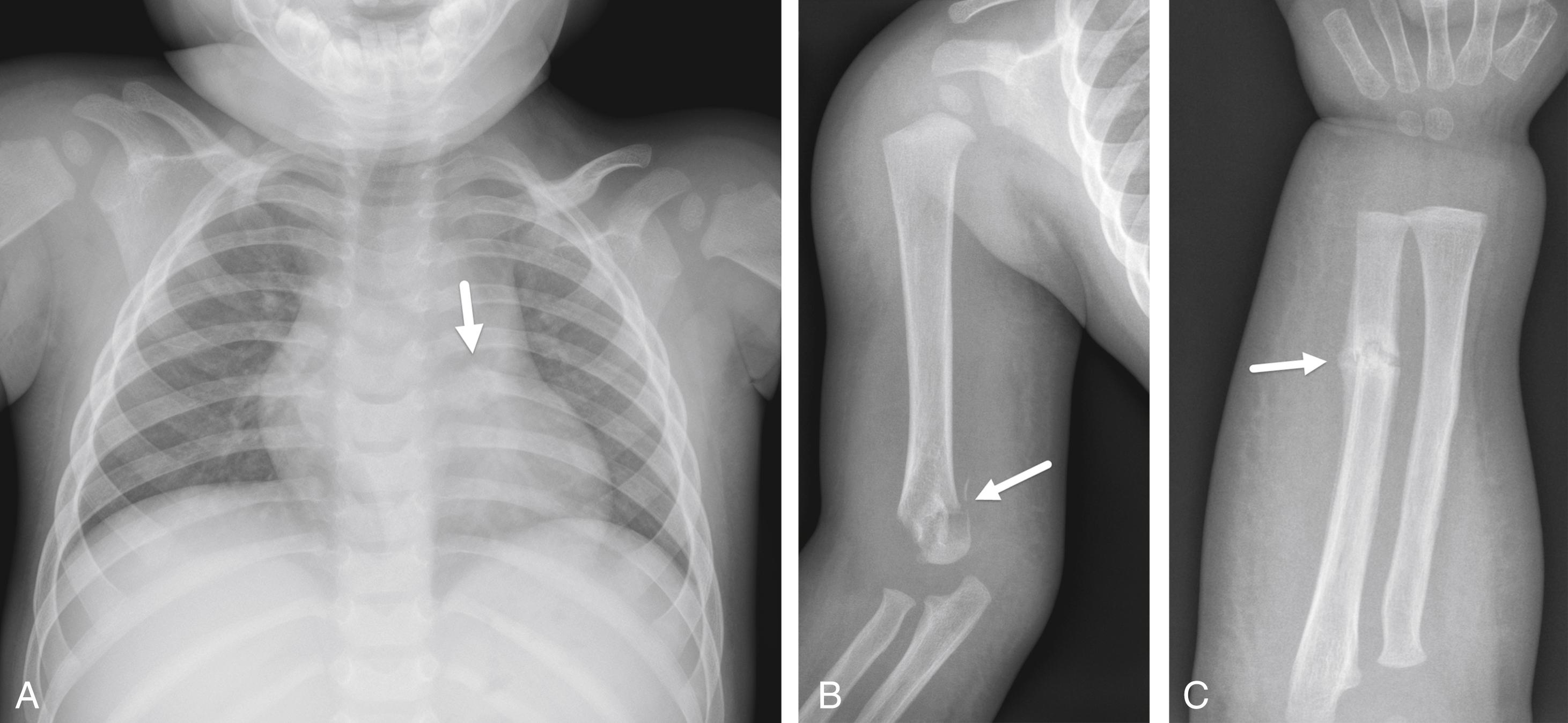
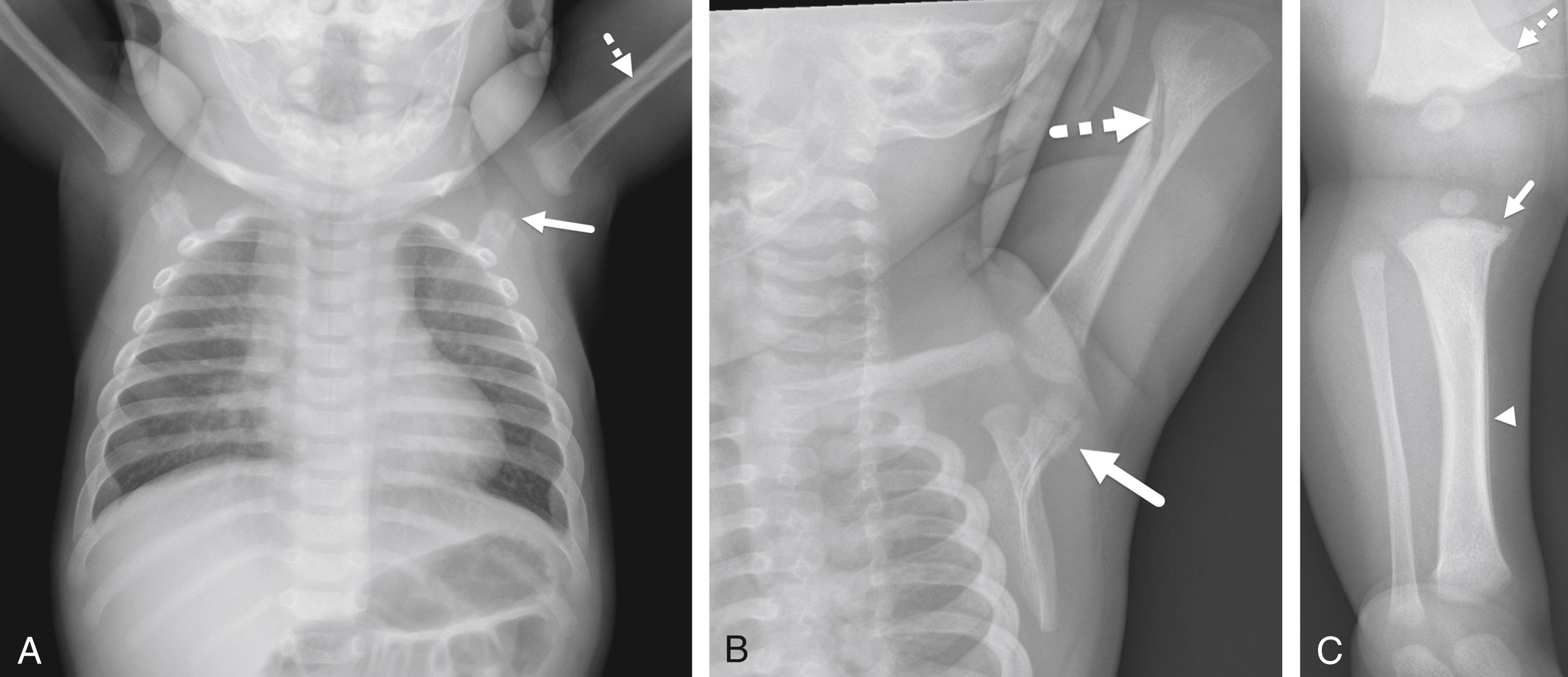
The clinical and imaging findings of abuse do not usually require a differential diagnosis. However, other entities that may cause multiple fractures or that may cause radiographic findings that could be confused with injury, such as periosteal reaction, should always be considered. The other disorders that may present with multiple fractures in an infant are osteogenesis imperfecta (OI) and Menkes syndrome. Both entities are also associated with excessive Wormian bones and osteopenia. Rickets, caused by vitamin D deficiency, is not a cause of the fractures specific for abuse. The imaging appearance of child abuse and that of rickets do not overlap.
When periosteal reaction is encountered in a newborn, there are several entities that must be considered ( Tables 7-1 ). They include physiologic new bone formation, TORCH infections (osteomyelitis), prostaglandin therapy, Caffey disease, metastatic neuroblastoma, and abuse. Physiologic periosteal new bone formation is the most common cause of diffuse periosteal new bone and can be seen in infants during the first few months of life. It typically involves rapidly growing long bones, such as the femur, tibia, and humerus. Differential features that support physiologic growth as the cause of periosteal reaction include symmetric distribution, benign appearance of the periosteal reaction, and appropriate age of the child. Radiographs may show lines of periosteal reaction paralleling the cortex of the diaphysis of the long bones. Neonates with congenital heart disease are commonly treated with prostaglandins to maintain patency of the ductus venosus. These children commonly demonstrate prominent periosteal reaction ( Fig. 7-50 ).
|
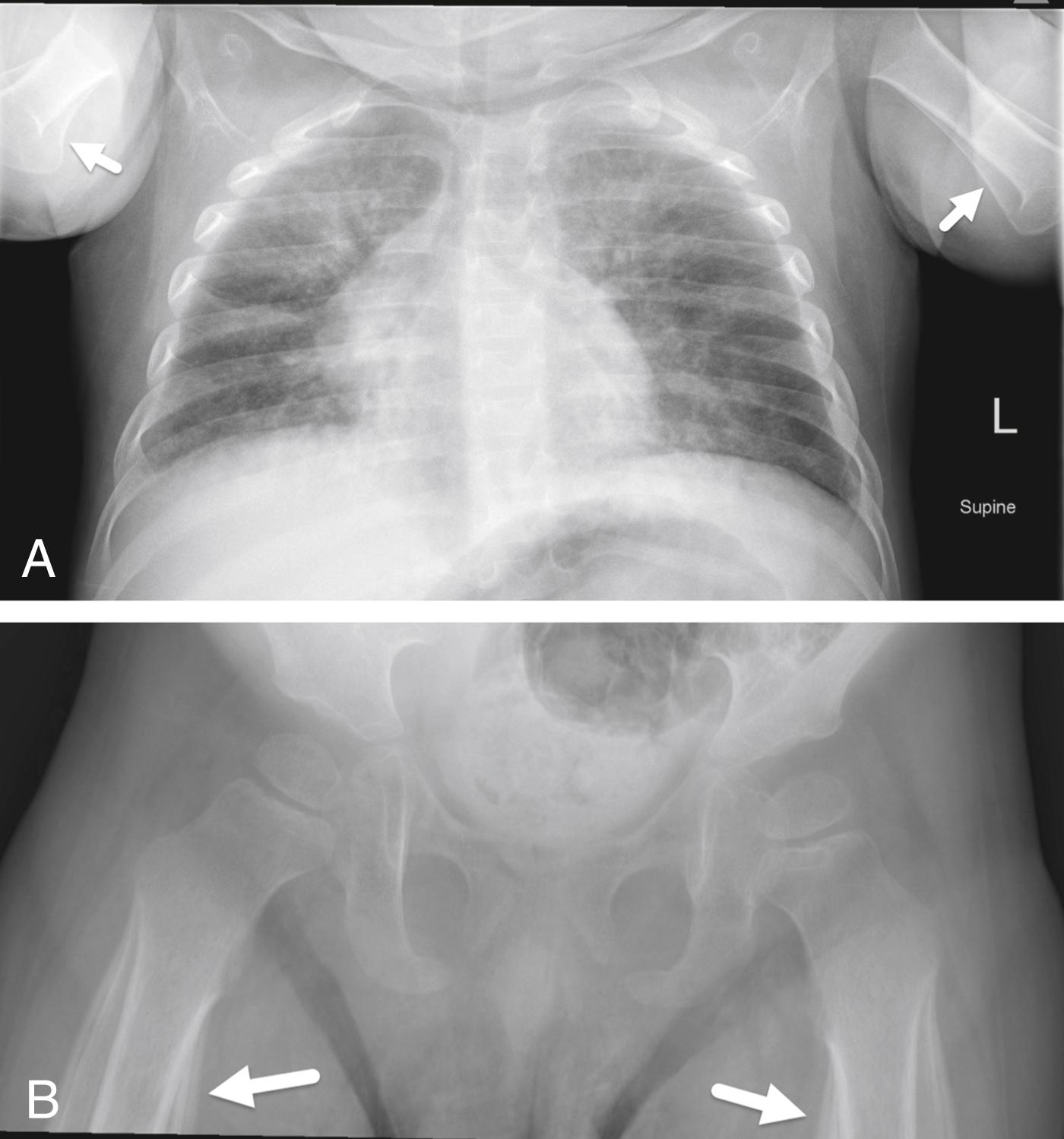
The differential diagnosis for transplacentally acquired infections can be remembered by the mnemonic TORCH: toxoplasmosis, other (syphilis), rubella, cytomegalovirus, and herpes.
Rubella was once the most common transplacental viral infection. Since the introduction of the rubella vaccine, the incidence of congenital rubella has plummeted. Its features include eye abnormalities, deafness, hepatosplenomegaly, aortic and pulmonic stenosis, and intrauterine growth restriction. Bony changes are present in as many as 50% of cases. They include irregular fraying of the metaphyses of long bones and generalized lucency of the metaphyses. The findings have been likened to a celery-stalk appearance. These radiographic findings are most apparent during the first few weeks of life. The bony manifestations of rubella are currently extremely rare.
Congenital syphilis occurs secondary to transplacental infection, usually occurring during the second or third trimester. Clinical findings include hepatosplenomegaly, rash, rhinorrhea, anemia, and ascites. Bony changes are present in as many as 95% of patients but often do not appear until 6–8 weeks after the time of infection. The radiographic findings may be present before the blood serology turns positive. Findings include nonspecific metaphyseal lucent bands, serrated metaphyses, multiple fractures, lytic skull lesions, and periosteal reaction involving multiple long bones. The Wimberger corner sign is the most specific finding of syphilis and consists of destruction of the medial portion of the proximal metaphysis of the tibia, resulting in an area of irregular lucency. Osseous manifestations of syphilis are much more commonly encountered than those of rubella or other TORCH infections.
Caffey disease is an idiopathic syndrome that consists of periosteal reaction shown on radiographs, irritability, fever, and soft tissue swelling over the areas of periosteal reaction. It occurs during the first few months of life. The bones most commonly involved include the mandible, clavicle, ribs, humerus, ulna, femur, scapula, and radius. Imaging shows periosteal new bone formation, sclerosis, and adjacent soft tissue swelling. The disease is self-limited and currently occurs much less commonly now than in the past for reasons that are not well-understood.
A bone lesion is considered permeative when it has poorly defined borders, a wide zone of transition, and multiple small, irregular holes centrally. As in an adult, a permeative bone lesion in a child is consistent with an aggressive inflammatory or neoplastic lesion. The more common causes of a permeative lesion in a child include osteomyelitis, Langerhans cell histiocytosis (LCH), neuroblastoma metastasis, Ewing sarcoma, and lymphoma or leukemia. The differential diagnosis can be further limited by considering the patient's age ( Tables 7-2 ). If the patient is younger than five years of age, the most likely diagnoses include osteomyelitis, LCH, and metastatic neuroblastoma. Ewing sarcoma and lymphoma are exceedingly rare in children younger than five years of age. In older children, Ewing sarcoma and lymphoma or leukemia become candidates, and metastatic neuroblastoma becomes much less likely.
| Younger than five years of Age | Older than five years of Age |
|---|---|
| Osteomyelitis | Ewing sarcoma |
| Langerhans cell histiocytosis | Lymphoma or leukemia |
| Neuroblastoma metastasis | OsteomyelitisLangerhans cell histiocytosis |
Acute osteomyelitis is a relatively common cause of clinically significant bone pathology in children. It is primarily a disease of infants and young children; one third of cases occur in children younger than two years of age, and one half of cases occur before five years of age. Because of the young age of most of the children, the presentation is often nonspecific, and diagnosis is delayed. Erythrocyte sedimentation rate is elevated in a vast majority of cases. Most cases of osteomyelitis are hematogenous in origin; many patients have a recent history of respiratory tract infection or otitis media. Staphylococcus aureus is the most common cause, accounting for more than 80% of cases.
Osteomyelitis tends to occur in the metaphyses or metaphyseal equivalents of children. This is related to the rich and slow-moving blood supply to these regions. Approximately 75% of cases involve the metaphyses of long bones with the most common sites being the femur, tibia, and humerus. The other 25% of cases occur within metaphyseal equivalents of flat bones such as the pelvis.
The earliest radiographic finding of osteomyelitis is deep soft tissue swelling evidenced by displacement or obliteration of the fat planes adjacent to a metaphysis. Osseous changes may not be present until 10 days after the onset of symptoms. Initial bony changes consist of poorly defined lucency involving a metaphyseal area ( Fig. 7-51 ). Progressive bone destruction is often present. Periosteal new bone formation begins at approximately 10 days. Osteomyelitis can appear as sclerotic, rather than lucent, when it is a chronic process.
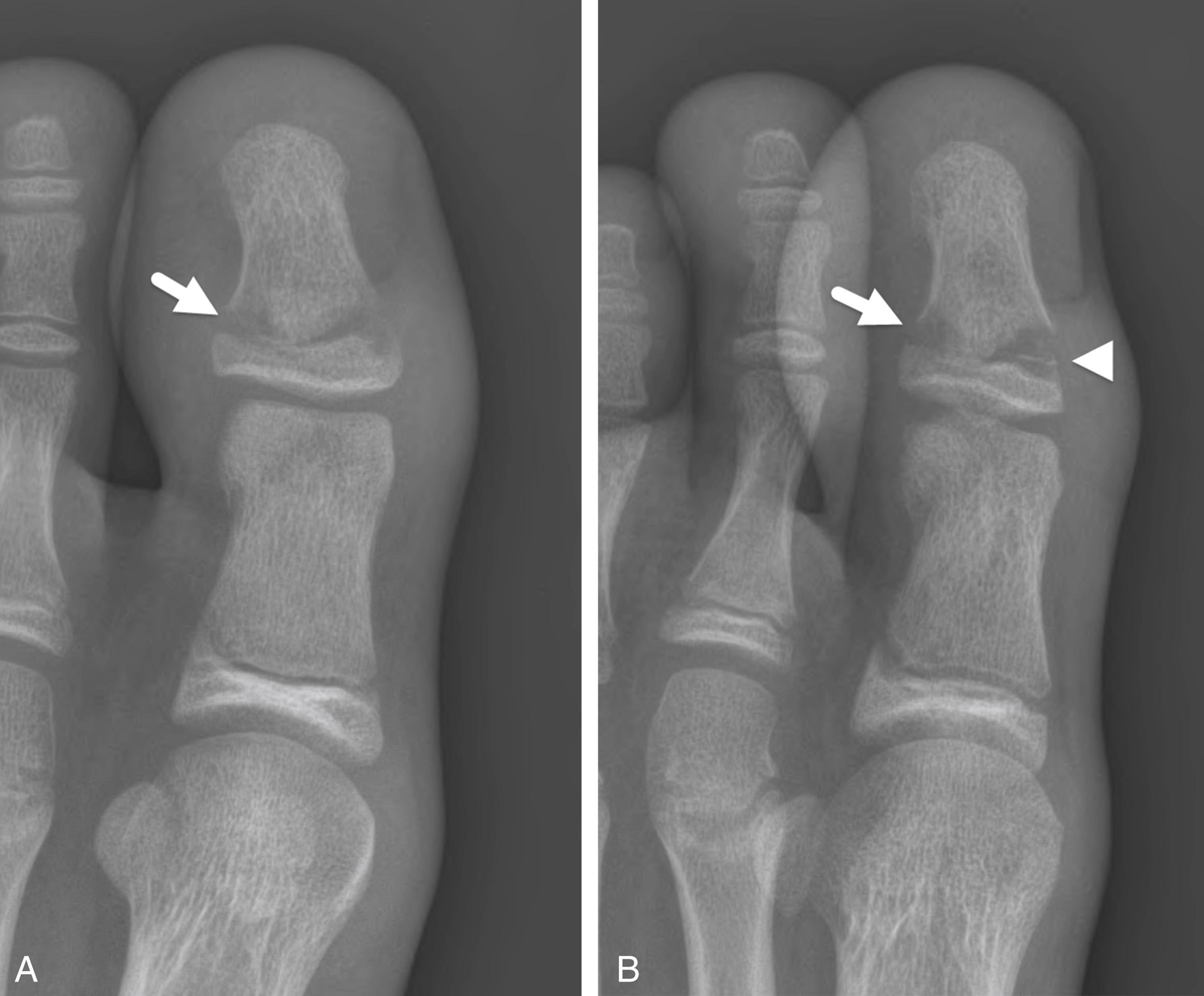
MRI has become the dominant imaging study in the work-up of osteomyelitis. Many institutions use a wide field of view T2-weighted MRI sequence to screen the affected region in symptomatic young children and then perform a more focused exam in areas of identified abnormalities. Osteomyelitis appears as an area of increased T2-weighted signal within a metaphysis. There are usually large areas of surrounding edema within the adjacent bone marrow and soft tissues. Gadolinium administration may show areas of nonenhancement suspicious for necrosis or abscess formation. Identification of subperiosteal abscesses is one of the advantages of MRI.
Skeletal scintigraphy, using technetium 99m-methyl diphosphonate, has become a much less common test to evaluate for osteomyelitis. On skeletal scintigraphy, osteomyelitis appears as a focal area of increased activity on the angiographic, soft tissue, and skeletal phase images. Skeletal scintigraphy becomes positive early after the onset of osteomyelitis and is often positive before development of changes seen on radiography. Another advantage of scintigraphy is the ability to evaluate for multiple sites of involvement.
A Brodie abscess is a unique form of osteomyelitis. It represents subacute pyogenic osteomyelitis. On X-ray or CT, a Brodie abscess appears as a focal lucent lesion surrounded by a rim of sclerosis ( Fig. 7-52 ). Periosteal new bone formation may be present. While not always present, a tract extending from the focal lucency to the physis is considered pathognomonic. On MRI, the lesion can have variable signal appearance. The classic penumbra sign of increased T1 signal lining the rim of the abscess can help to confirm the diagnosis.
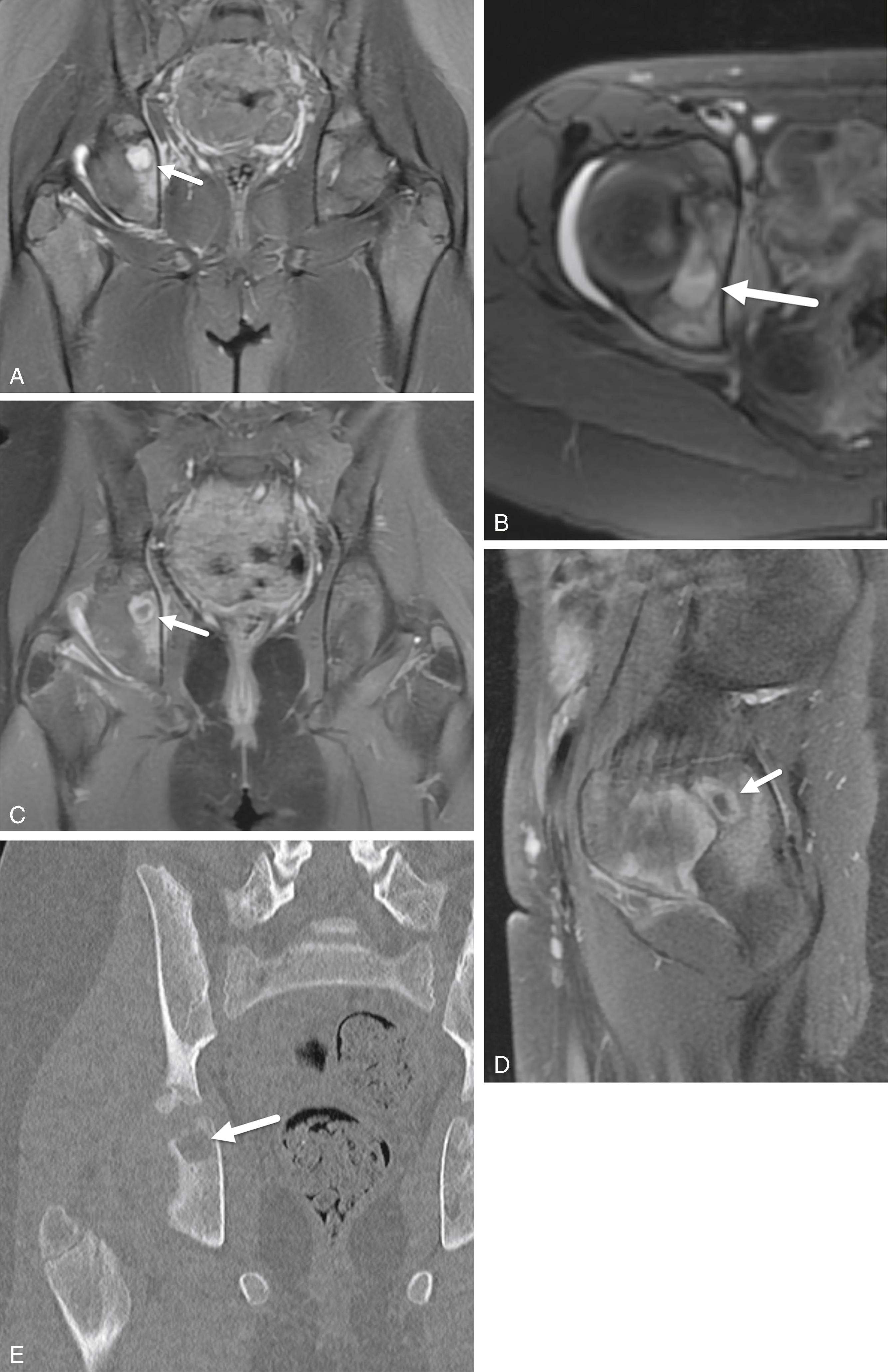
Oxacillin-resistant S. aureus (ORSA) deserves special mention as it accounts for over half of all cases of pediatric osteomyelitis. Patients with ORSA osteomyelitis often have a more severe infection and require more therapy than those children with oxacillin-sensitive S. aureus . ORSA osteomyelitis has a unique pattern on MRI, with a mottled heterogeneous appearance of the marrow (see Fig. 7-53 ) and extensive subperiosteal rim-enhancing collections. At times, the marrow signal abnormalities are only identified on contrast-enhanced images, where they appear as areas of absent enhancement.

LCH is an idiopathic disorder that can manifest as focal, localized, or systemic disease. It remains unclear whether the disease process is inflammatory or neoplastic. It is characterized by abnormal proliferation of Langerhans cells. The disease is twice as common in boys as in girls and occurs most commonly in Caucasians. It can occur as a single-system or multisystem disease with or without organ involvement. Organs that may be involved include the liver, spleen, lungs, and bone marrow.
Common sites of disease include bones, the skin, and pituitary. Bone is the most common site of disease, occurring in up to 80% of patients. Up to half of all lesions occur in the skull ( Fig. 7-54 ), with the remaining sites of involvement scattered throughout the appendicular skeleton, including the proximal limbs (20%), pelvis and scapula (12%), vertebral bodies (10%), and the distal limbs (5%). On radiograph, lesions appear as a well-demarcated, lytic lesion without peripheral sclerosis. Skull lesions may have a beveled edge when viewed en face or a target appearance when viewed straight on because of uneven destruction of the inner and outer tables of the skull. When the spine is involved, a classic finding is vertebral plana (vertebral destruction with severe collapse; Fig. 7-55 ).
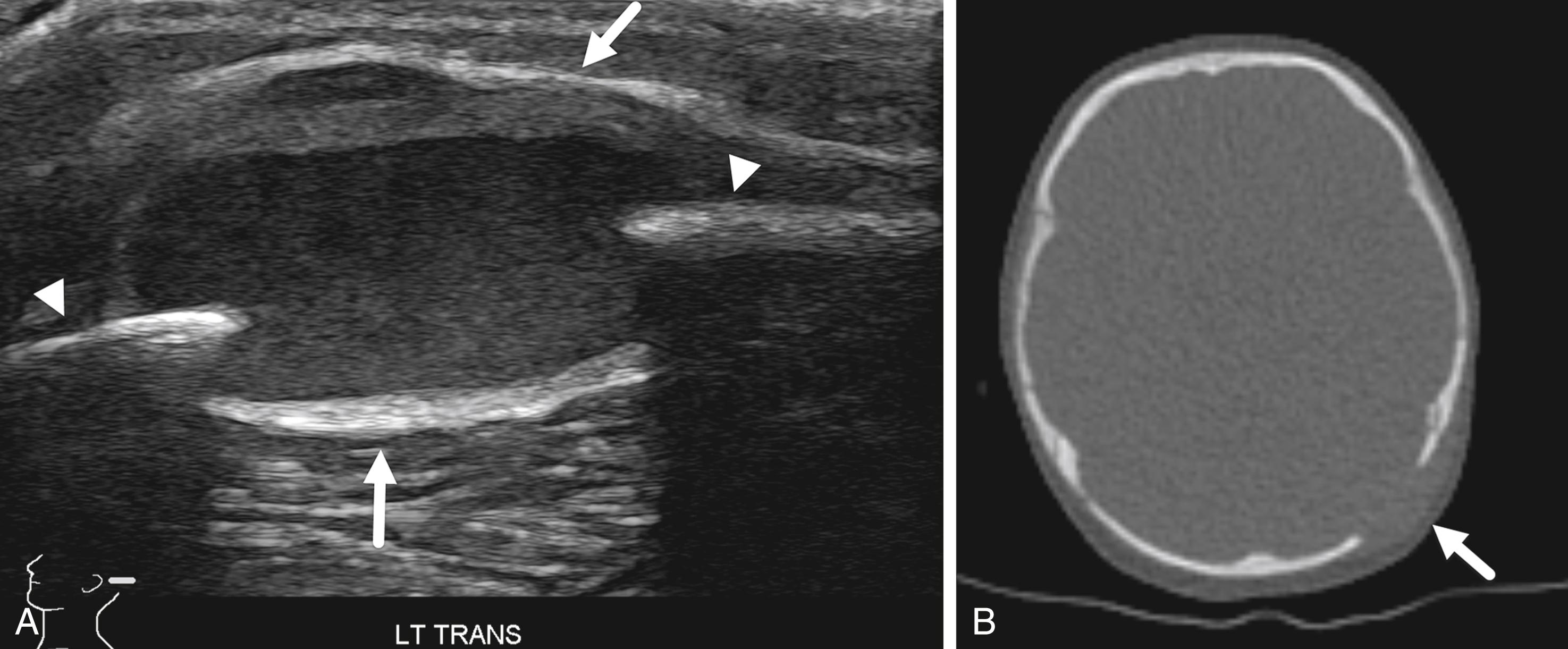
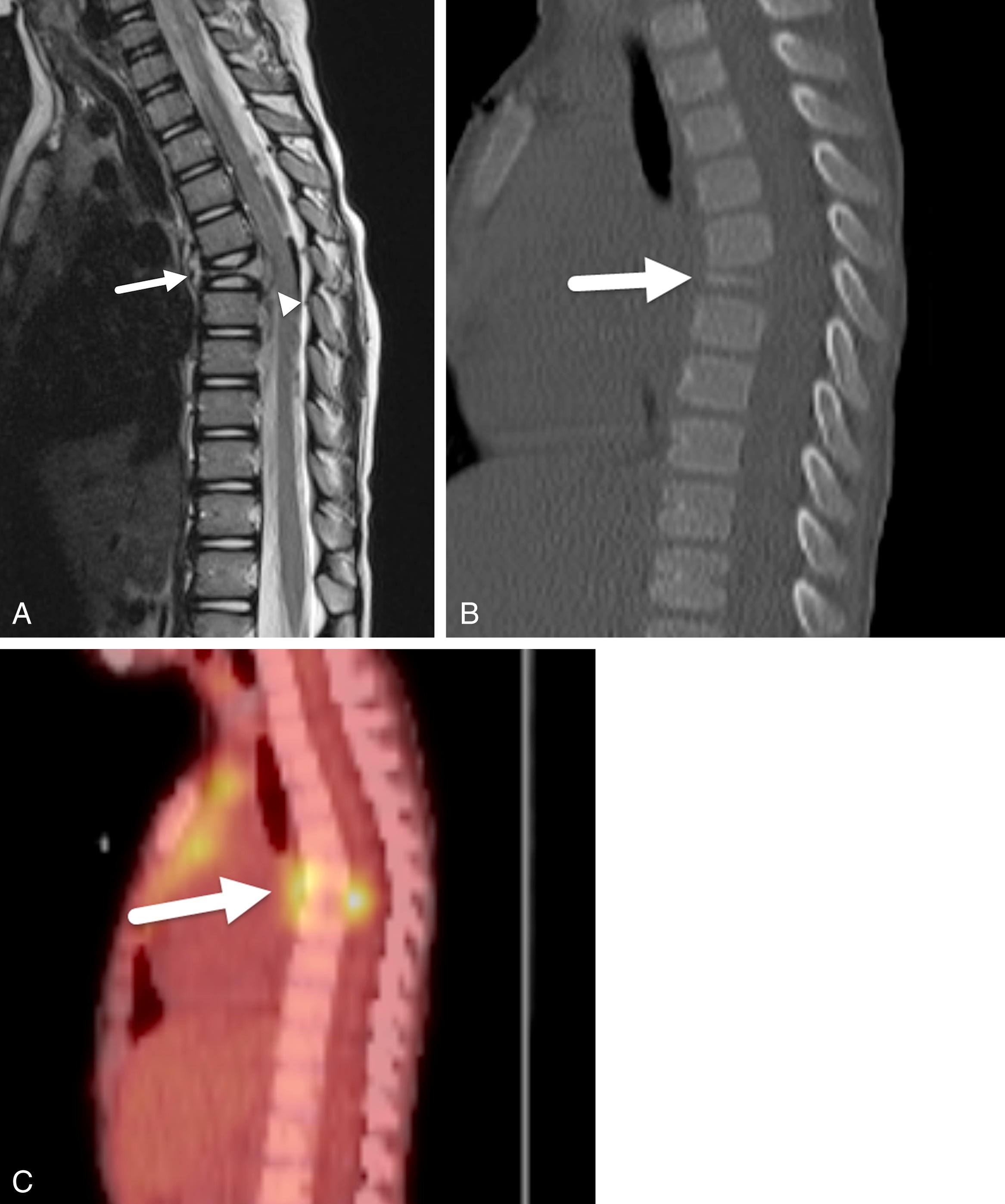
A child who presents with a lesion suspicious for LCH should be evaluated whole body positron emission tomography (PET)-CT to identify other osseous lesions and to identify pulmonary involvement. If needed, MRI or diagnostic CT can better characterize intraabdominal organ involvement. When PET-CT is performed, affected areas show increased uptake.
After osteosarcoma, Ewing sarcoma is the second most common primary bone malignancy in children. It is an aggressive, small, round, blue cell tumor similar to primitive neuroectodermal tumor. Ewing sarcoma most commonly occurs in the second decade of life. The most common sites of involvement, in decreasing order of frequency, are the femur, pelvis, tibia, humerus, and ribs. Two thirds of cases involve the pelvis or lower extremity. While Ewing sarcoma most commonly occurs in long bones, it has a greater propensity for flat bones compared with other primary bone malignancies.
The radiographic appearance of Ewing sarcoma is variable. Most lesions involve the metaphysis, but diaphyseal involvement is more common than in other bone malignancies. Most lesions have an aggressive appearance: a lucent lesion with poorly defined borders and a permeative appearance in the cortex ( Figs. 7-56 and 7-57 ). Aggressive-appearing periosteal new bone formation (spiculated, onion skin, Codman triangle) is commonly present. However, Ewing sarcoma can appear predominantly sclerotic in as many as 15% of cases. MRI demonstrates a destructive bony mass, often with an associated soft tissue component. The five-year survival rate for those with Ewing sarcoma is 82% in those with localized disease and 39% in those in whom metastatic disease is present. Metastases primarily occur in other sites of bone and the lungs.


In children, most cases of metastatic disease result from small, round, blue cell tumors. The most common primary neoplasms to metastasize to bone are neuroblastoma and leukemia or lymphoma. In any child younger than three years of age with a neoplastic bony lesion, metastatic neuroblastoma ( Figs. 7-58 and 7-59 ) should be considered and is much more likely than a primary bone neoplasm. Leukemia and lymphoma may deposit in the regions of the metaphyses and cause bony destruction. The appearance is often that of lucent metaphyseal bands ( Figs. 7-60 and 7-61 ). These nonspecific bands are often referred to as leukemic lines. Primary bone lymphoma is rare in children.
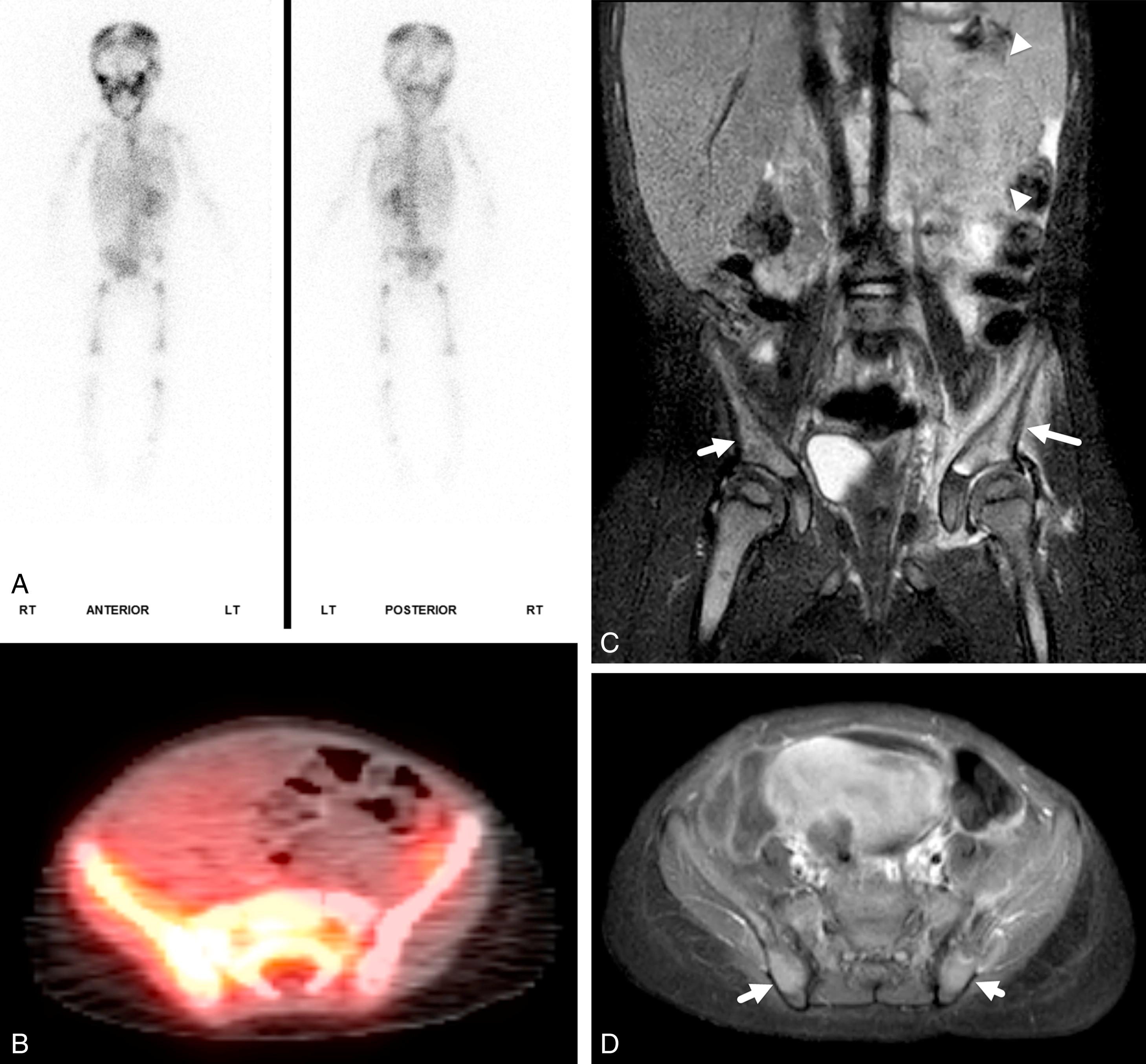
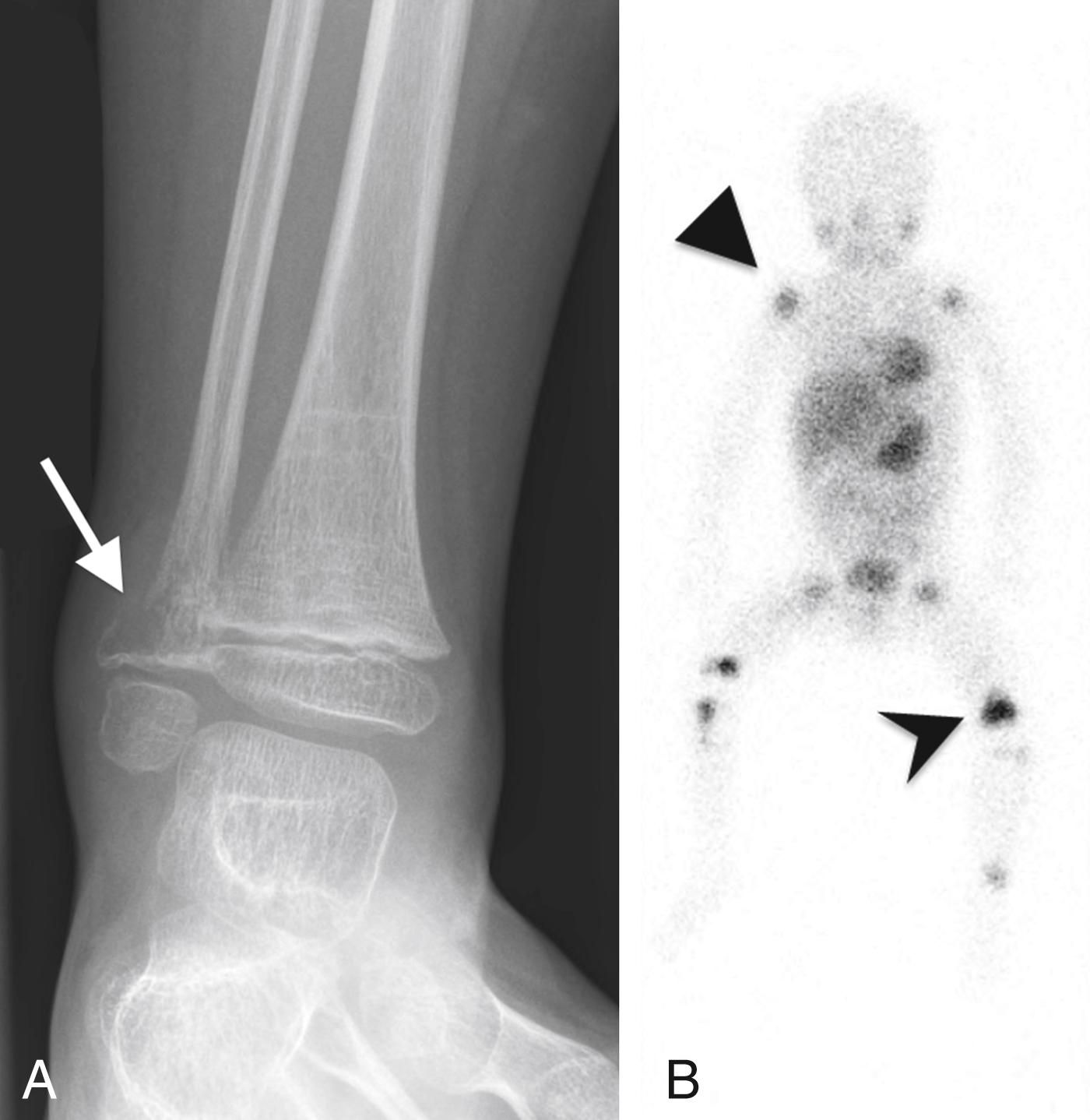
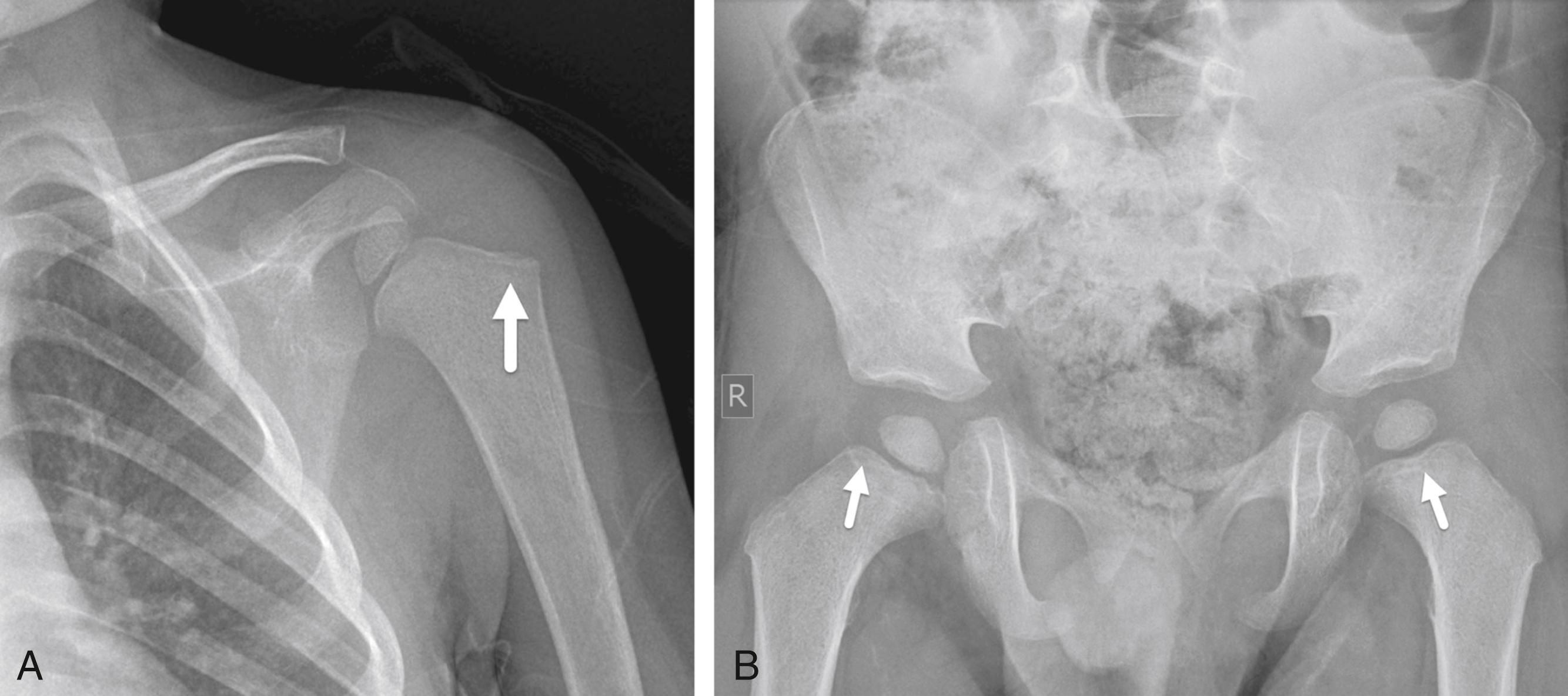

Become a Clinical Tree membership for Full access and enjoy Unlimited articles
If you are a member. Log in here